Cholon saigon Black & White Stock Photos
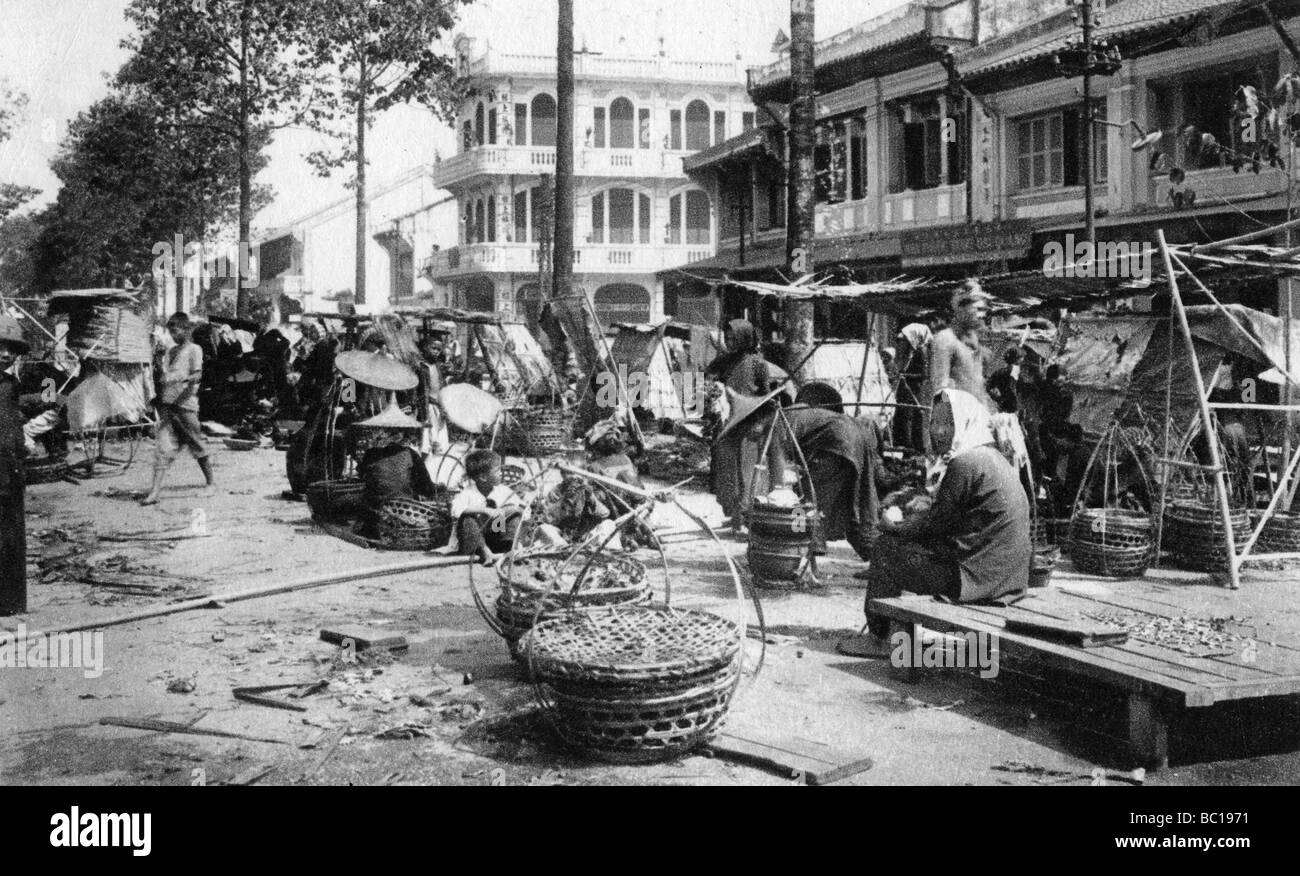 Market, Cholon, Saigon, Vietnam, 20th century(?). Artist: Unknown Stock Photohttps://www.alamy.com/image-license-details/?v=1https://www.alamy.com/stock-photo-market-cholon-saigon-vietnam-20th-century-artist-unknown-24615445.html
Market, Cholon, Saigon, Vietnam, 20th century(?). Artist: Unknown Stock Photohttps://www.alamy.com/image-license-details/?v=1https://www.alamy.com/stock-photo-market-cholon-saigon-vietnam-20th-century-artist-unknown-24615445.htmlRMBC1971–Market, Cholon, Saigon, Vietnam, 20th century(?). Artist: Unknown
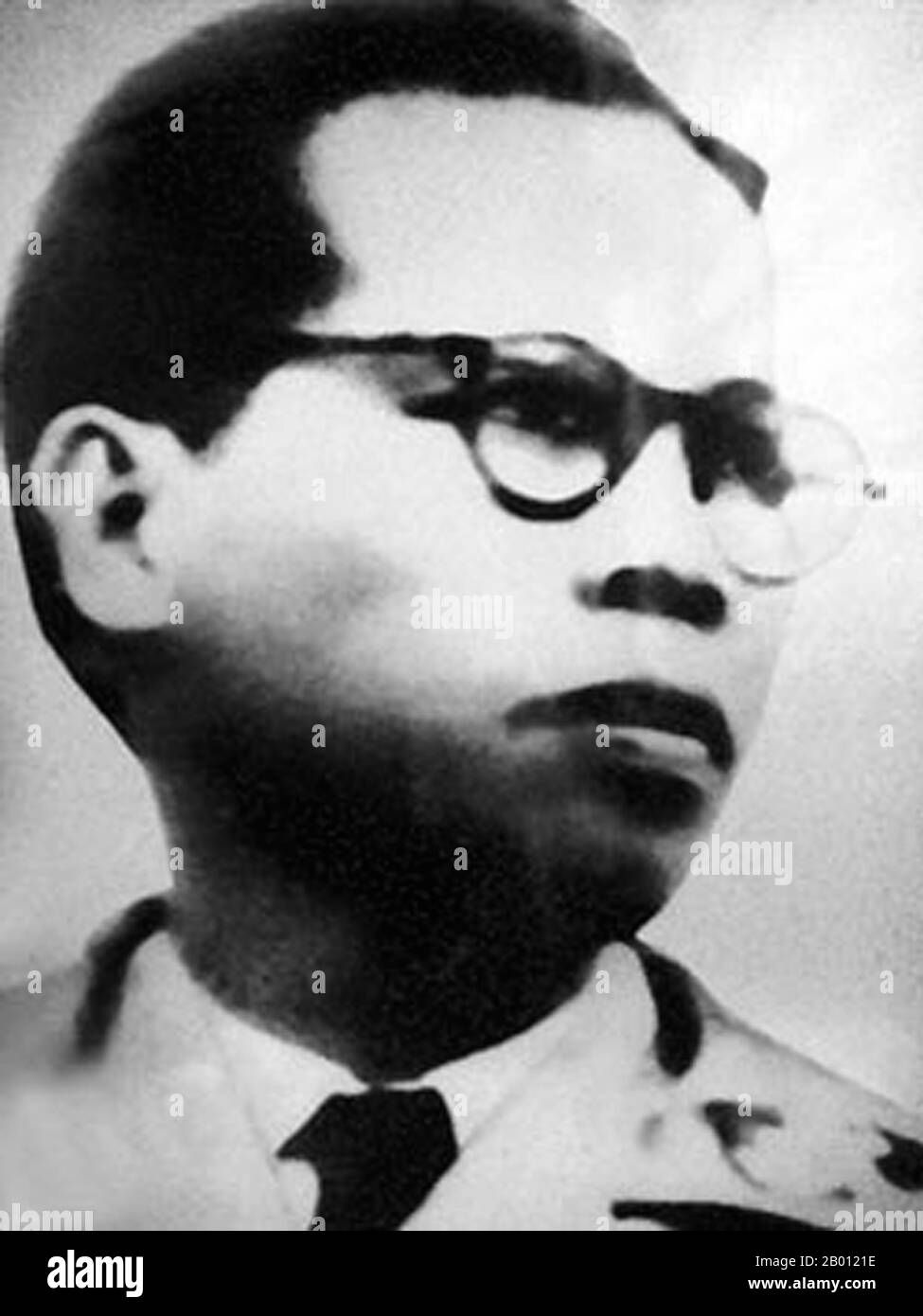 Vietnam: Le Van Vien, aka Bay Vien (1904-1970), leader of the Binh Xuyen criminal-military organisation in Saigon and Cholon in the 1950s. Bình Xuyên, often linked to its infamous leader, General Le Van 'Bay' Vien, was an independent military force within the Vietnamese National Army whose leaders once had lived outside the law and had sided with the Viet Minh. During its heyday, Binh Xuyen funded itself with organied crime activities in Saigon while effectively battling Communist forces. Binh Xuyen was located in Nha Be, in the marshes and canals along the southern fringes of Saigon-Cholon. Stock Photohttps://www.alamy.com/image-license-details/?v=1https://www.alamy.com/vietnam-le-van-vien-aka-bay-vien-1904-1970-leader-of-the-binh-xuyen-criminal-military-organisation-in-saigon-and-cholon-in-the-1950s-bnh-xuyn-often-linked-to-its-infamous-leader-general-le-van-bay-vien-was-an-independent-military-force-within-the-vietnamese-national-army-whose-leaders-once-had-lived-outside-the-law-and-had-sided-with-the-viet-minh-during-its-heyday-binh-xuyen-funded-itself-with-organied-crime-activities-in-saigon-while-effectively-battling-communist-forces-binh-xuyen-was-located-in-nha-be-in-the-marshes-and-canals-along-the-southern-fringes-of-saigon-cholon-image344230922.html
Vietnam: Le Van Vien, aka Bay Vien (1904-1970), leader of the Binh Xuyen criminal-military organisation in Saigon and Cholon in the 1950s. Bình Xuyên, often linked to its infamous leader, General Le Van 'Bay' Vien, was an independent military force within the Vietnamese National Army whose leaders once had lived outside the law and had sided with the Viet Minh. During its heyday, Binh Xuyen funded itself with organied crime activities in Saigon while effectively battling Communist forces. Binh Xuyen was located in Nha Be, in the marshes and canals along the southern fringes of Saigon-Cholon. Stock Photohttps://www.alamy.com/image-license-details/?v=1https://www.alamy.com/vietnam-le-van-vien-aka-bay-vien-1904-1970-leader-of-the-binh-xuyen-criminal-military-organisation-in-saigon-and-cholon-in-the-1950s-bnh-xuyn-often-linked-to-its-infamous-leader-general-le-van-bay-vien-was-an-independent-military-force-within-the-vietnamese-national-army-whose-leaders-once-had-lived-outside-the-law-and-had-sided-with-the-viet-minh-during-its-heyday-binh-xuyen-funded-itself-with-organied-crime-activities-in-saigon-while-effectively-battling-communist-forces-binh-xuyen-was-located-in-nha-be-in-the-marshes-and-canals-along-the-southern-fringes-of-saigon-cholon-image344230922.htmlRM2B0121E–Vietnam: Le Van Vien, aka Bay Vien (1904-1970), leader of the Binh Xuyen criminal-military organisation in Saigon and Cholon in the 1950s. Bình Xuyên, often linked to its infamous leader, General Le Van 'Bay' Vien, was an independent military force within the Vietnamese National Army whose leaders once had lived outside the law and had sided with the Viet Minh. During its heyday, Binh Xuyen funded itself with organied crime activities in Saigon while effectively battling Communist forces. Binh Xuyen was located in Nha Be, in the marshes and canals along the southern fringes of Saigon-Cholon.
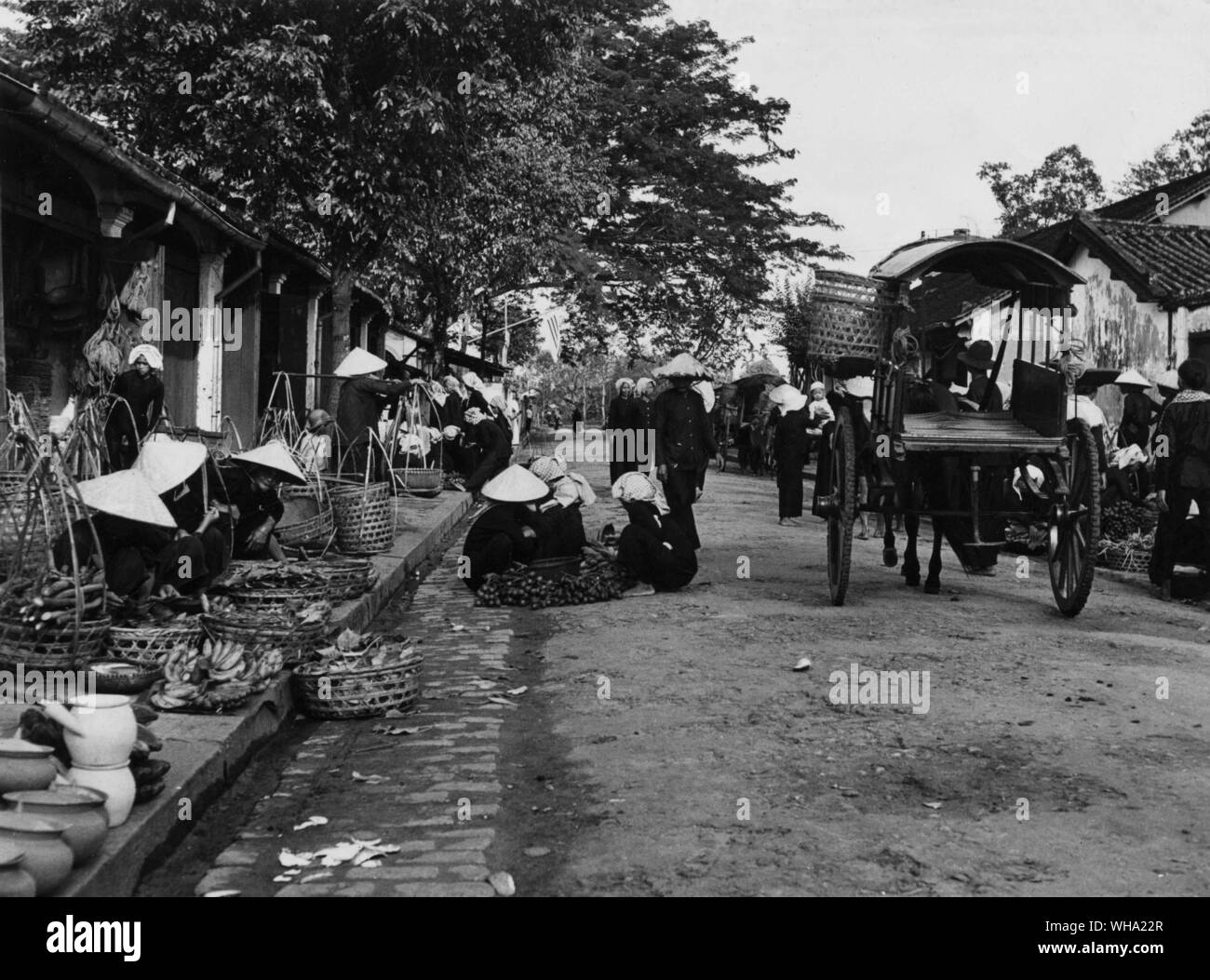 Vietnam war: Saigon, the capital of South Vietnam lies on the right bank of the sea. Enclosed north to south by rivers Arroyo and Avalancho, it extends westwards to the neighbouring Chinese town of Cholon. The commercial port, at the south of the Chinese Arroyo, is engaged in a large rice trade. Stock Photohttps://www.alamy.com/image-license-details/?v=1https://www.alamy.com/vietnam-war-saigon-the-capital-of-south-vietnam-lies-on-the-right-bank-of-the-sea-enclosed-north-to-south-by-rivers-arroyo-and-avalancho-it-extends-westwards-to-the-neighbouring-chinese-town-of-cholon-the-commercial-port-at-the-south-of-the-chinese-arroyo-is-engaged-in-a-large-rice-trade-image268825839.html
Vietnam war: Saigon, the capital of South Vietnam lies on the right bank of the sea. Enclosed north to south by rivers Arroyo and Avalancho, it extends westwards to the neighbouring Chinese town of Cholon. The commercial port, at the south of the Chinese Arroyo, is engaged in a large rice trade. Stock Photohttps://www.alamy.com/image-license-details/?v=1https://www.alamy.com/vietnam-war-saigon-the-capital-of-south-vietnam-lies-on-the-right-bank-of-the-sea-enclosed-north-to-south-by-rivers-arroyo-and-avalancho-it-extends-westwards-to-the-neighbouring-chinese-town-of-cholon-the-commercial-port-at-the-south-of-the-chinese-arroyo-is-engaged-in-a-large-rice-trade-image268825839.htmlRMWHA22R–Vietnam war: Saigon, the capital of South Vietnam lies on the right bank of the sea. Enclosed north to south by rivers Arroyo and Avalancho, it extends westwards to the neighbouring Chinese town of Cholon. The commercial port, at the south of the Chinese Arroyo, is engaged in a large rice trade.
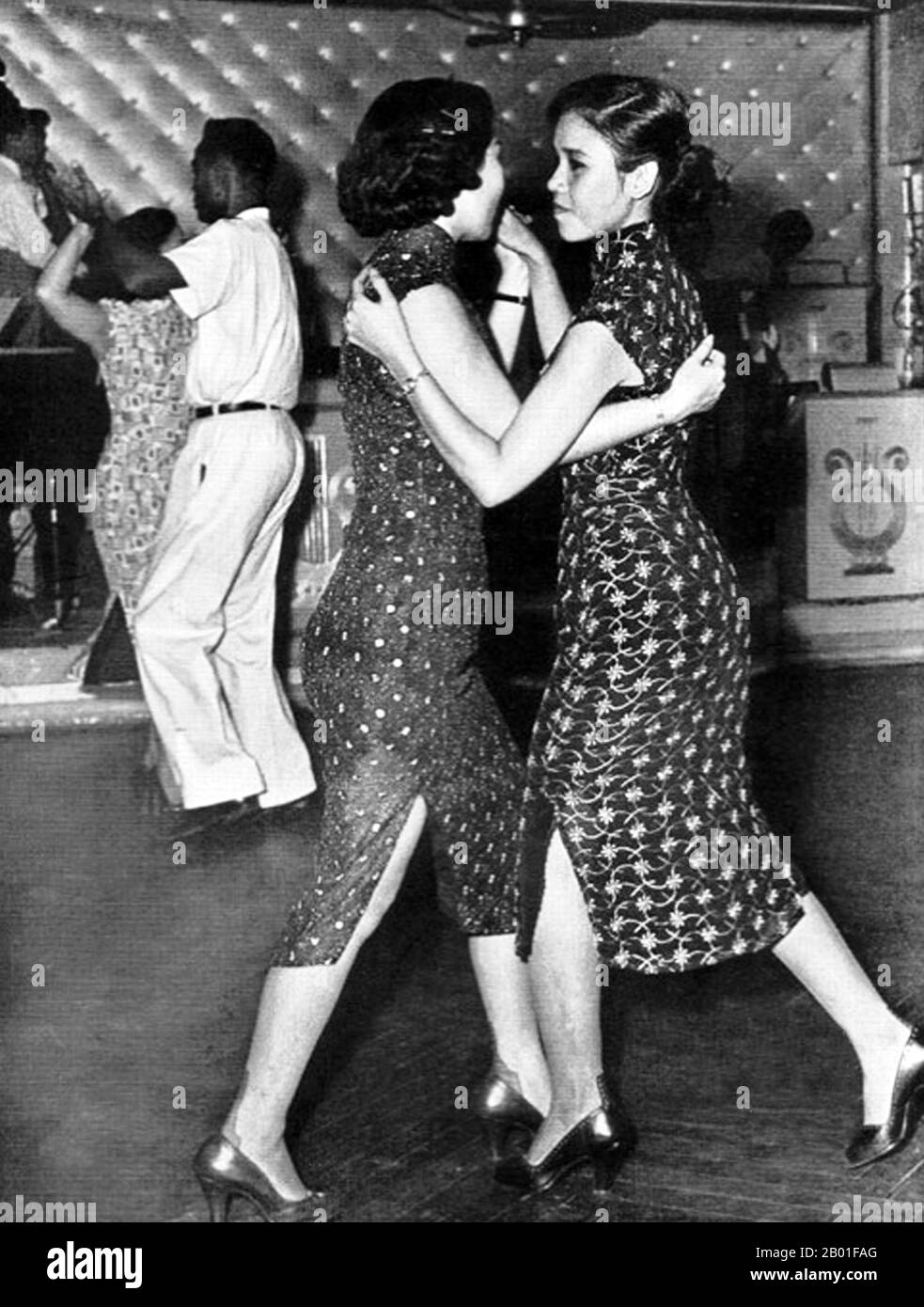 Vietnam: Taxi dancers dancing together at the Arc-en-Ciel Club on Jaccareo Road, Cholon, c. 1952. The Arc-en-Ciel was arguably Saigon's top night spot during the 1940s and 1950s. Located in Saigon's twin city of Cholon on Jaccareo Avenue - today's Tan Da - it features prominently in Graham Greene's 'The Quiet American' as the taxi dance venue where Thomas Fowler met and wooed Phuong. Stock Photohttps://www.alamy.com/image-license-details/?v=1https://www.alamy.com/vietnam-taxi-dancers-dancing-together-at-the-arc-en-ciel-club-on-jaccareo-road-cholon-c-1952-the-arc-en-ciel-was-arguably-saigons-top-night-spot-during-the-1940s-and-1950s-located-in-saigons-twin-city-of-cholon-on-jaccareo-avenue-todays-tan-da-it-features-prominently-in-graham-greenes-the-quiet-american-as-the-taxi-dance-venue-where-thomas-fowler-met-and-wooed-phuong-image344241368.html
Vietnam: Taxi dancers dancing together at the Arc-en-Ciel Club on Jaccareo Road, Cholon, c. 1952. The Arc-en-Ciel was arguably Saigon's top night spot during the 1940s and 1950s. Located in Saigon's twin city of Cholon on Jaccareo Avenue - today's Tan Da - it features prominently in Graham Greene's 'The Quiet American' as the taxi dance venue where Thomas Fowler met and wooed Phuong. Stock Photohttps://www.alamy.com/image-license-details/?v=1https://www.alamy.com/vietnam-taxi-dancers-dancing-together-at-the-arc-en-ciel-club-on-jaccareo-road-cholon-c-1952-the-arc-en-ciel-was-arguably-saigons-top-night-spot-during-the-1940s-and-1950s-located-in-saigons-twin-city-of-cholon-on-jaccareo-avenue-todays-tan-da-it-features-prominently-in-graham-greenes-the-quiet-american-as-the-taxi-dance-venue-where-thomas-fowler-met-and-wooed-phuong-image344241368.htmlRM2B01FAG–Vietnam: Taxi dancers dancing together at the Arc-en-Ciel Club on Jaccareo Road, Cholon, c. 1952. The Arc-en-Ciel was arguably Saigon's top night spot during the 1940s and 1950s. Located in Saigon's twin city of Cholon on Jaccareo Avenue - today's Tan Da - it features prominently in Graham Greene's 'The Quiet American' as the taxi dance venue where Thomas Fowler met and wooed Phuong.
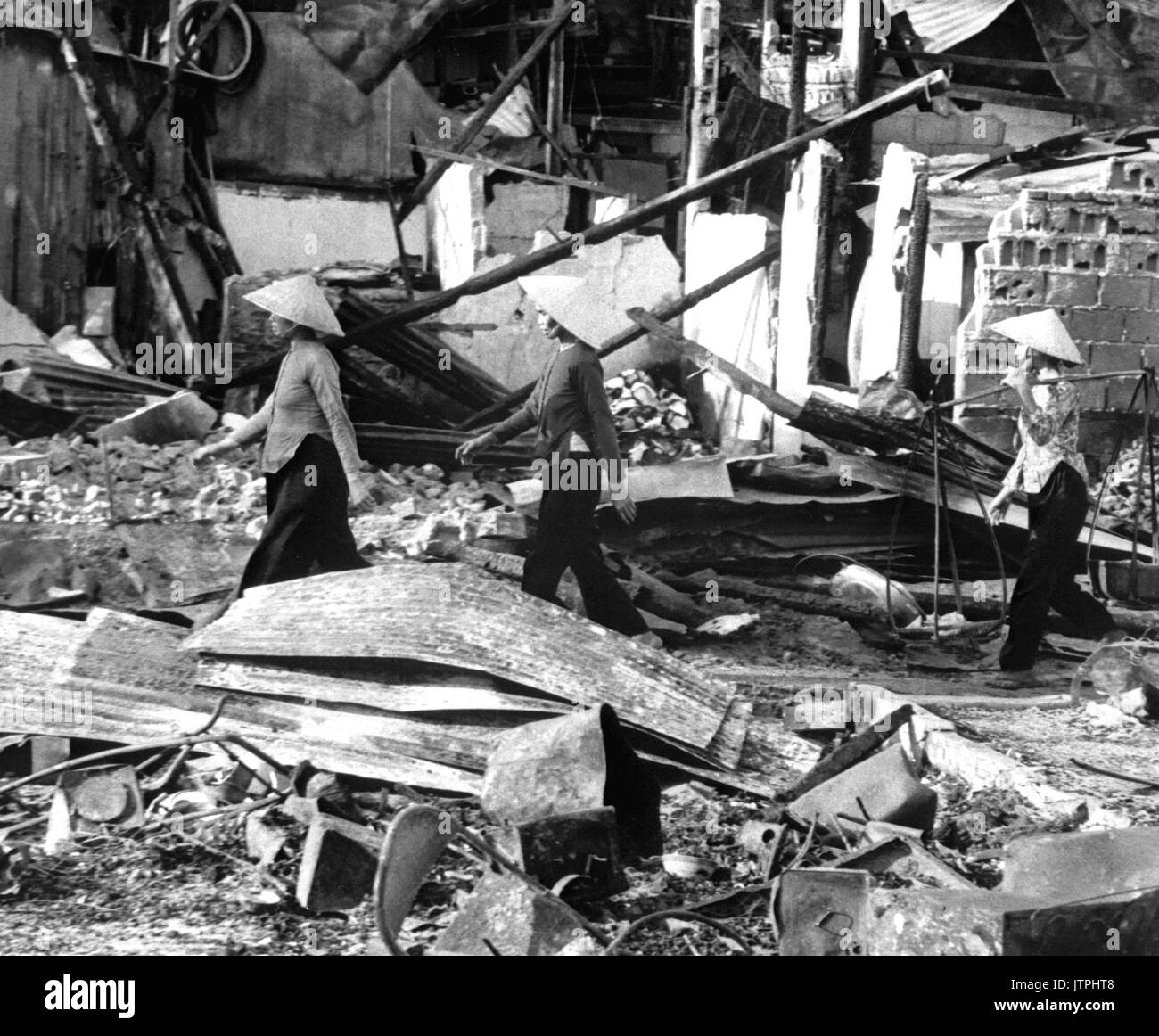 Three Vietnamese women move back into the Cholon area after VC attack that left a two-block area leveled, in hopes of salvaging meager belongings. Saigon, January 31, 1968. (USAIA) NARA FILE #: 306-MVP-5-4 WAR & CONFLICT BOOK #: 421 Stock Photohttps://www.alamy.com/image-license-details/?v=1https://www.alamy.com/three-vietnamese-women-move-back-into-the-cholon-area-after-vc-attack-image152931640.html
Three Vietnamese women move back into the Cholon area after VC attack that left a two-block area leveled, in hopes of salvaging meager belongings. Saigon, January 31, 1968. (USAIA) NARA FILE #: 306-MVP-5-4 WAR & CONFLICT BOOK #: 421 Stock Photohttps://www.alamy.com/image-license-details/?v=1https://www.alamy.com/three-vietnamese-women-move-back-into-the-cholon-area-after-vc-attack-image152931640.htmlRFJTPHT8–Three Vietnamese women move back into the Cholon area after VC attack that left a two-block area leveled, in hopes of salvaging meager belongings. Saigon, January 31, 1968. (USAIA) NARA FILE #: 306-MVP-5-4 WAR & CONFLICT BOOK #: 421
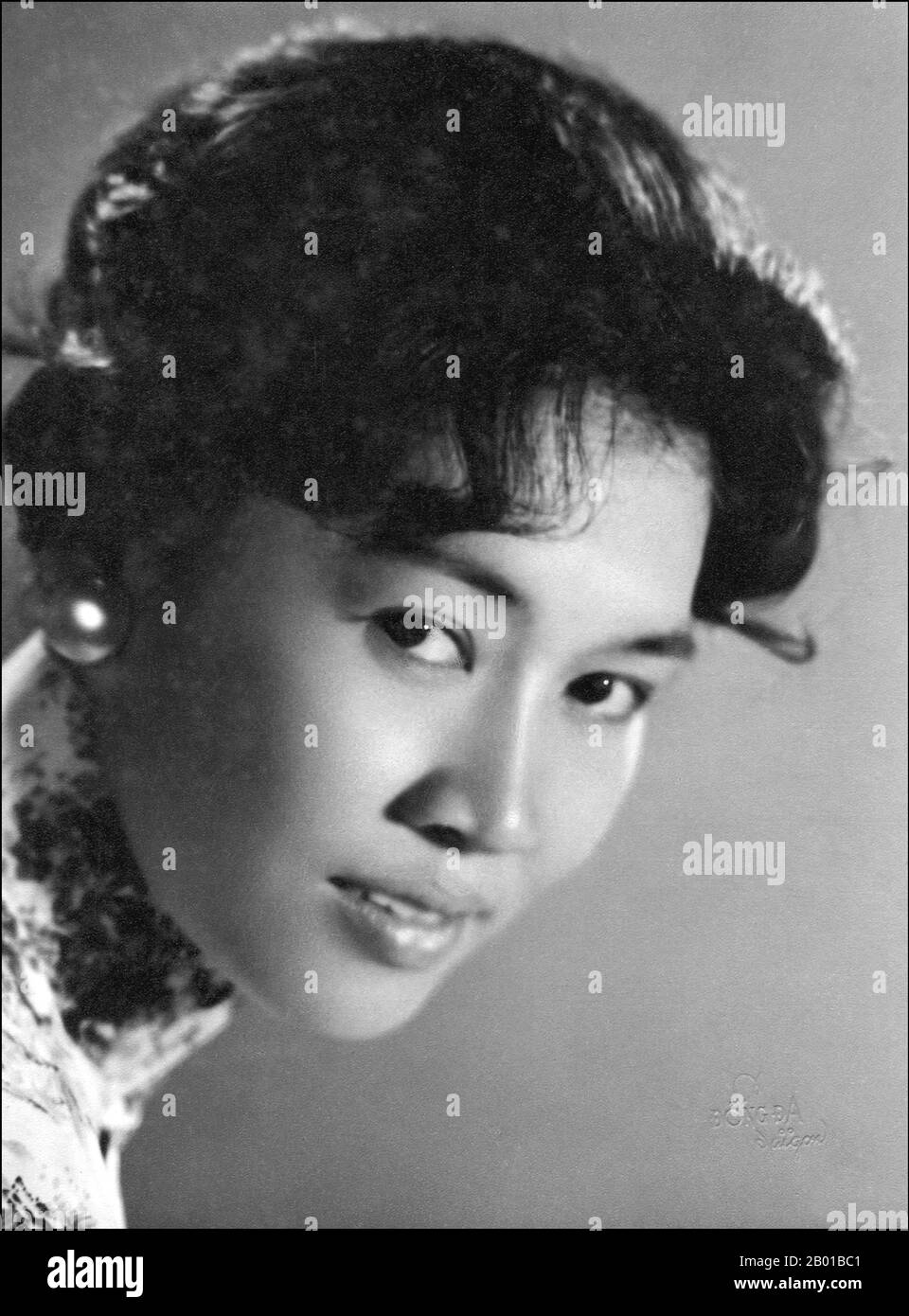 Vietnam: Portrait of a young Vietnamese woman in Saigon, c. 1960s. Photograph of an attractive unknown young woman in Saigon in the 1960s wearing an ao dai and with a 1960s hairstyle. Stock Photohttps://www.alamy.com/image-license-details/?v=1https://www.alamy.com/vietnam-portrait-of-a-young-vietnamese-woman-in-saigon-c-1960s-photograph-of-an-attractive-unknown-young-woman-in-saigon-in-the-1960s-wearing-an-ao-dai-and-with-a-1960s-hairstyle-image344238273.html
Vietnam: Portrait of a young Vietnamese woman in Saigon, c. 1960s. Photograph of an attractive unknown young woman in Saigon in the 1960s wearing an ao dai and with a 1960s hairstyle. Stock Photohttps://www.alamy.com/image-license-details/?v=1https://www.alamy.com/vietnam-portrait-of-a-young-vietnamese-woman-in-saigon-c-1960s-photograph-of-an-attractive-unknown-young-woman-in-saigon-in-the-1960s-wearing-an-ao-dai-and-with-a-1960s-hairstyle-image344238273.htmlRM2B01BC1–Vietnam: Portrait of a young Vietnamese woman in Saigon, c. 1960s. Photograph of an attractive unknown young woman in Saigon in the 1960s wearing an ao dai and with a 1960s hairstyle.
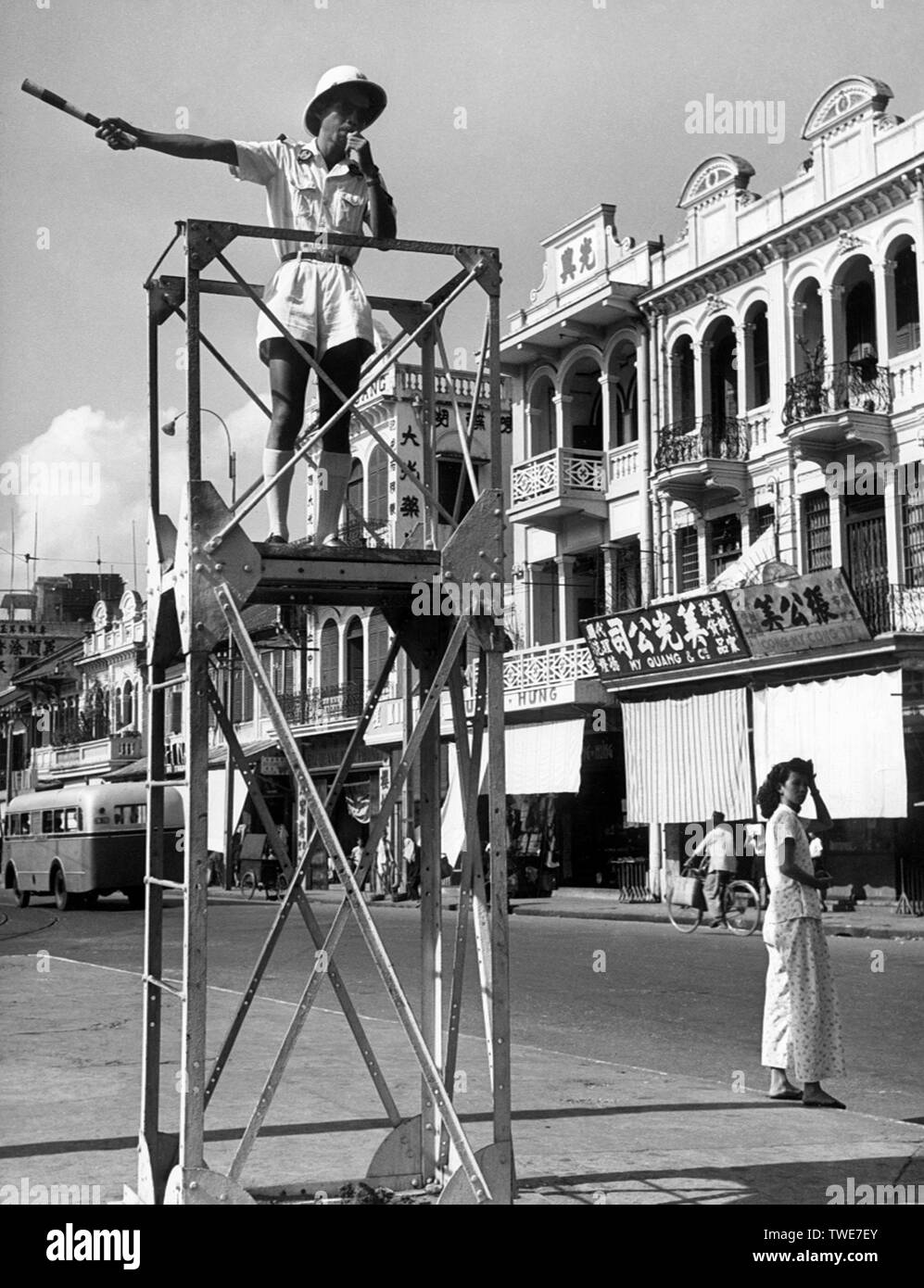 southern vietnam, saigon, a policeman in the center of cholon, 1958 Stock Photohttps://www.alamy.com/image-license-details/?v=1https://www.alamy.com/southern-vietnam-saigon-a-policeman-in-the-center-of-cholon-1958-image256624787.html
southern vietnam, saigon, a policeman in the center of cholon, 1958 Stock Photohttps://www.alamy.com/image-license-details/?v=1https://www.alamy.com/southern-vietnam-saigon-a-policeman-in-the-center-of-cholon-1958-image256624787.htmlRMTWE7EY–southern vietnam, saigon, a policeman in the center of cholon, 1958
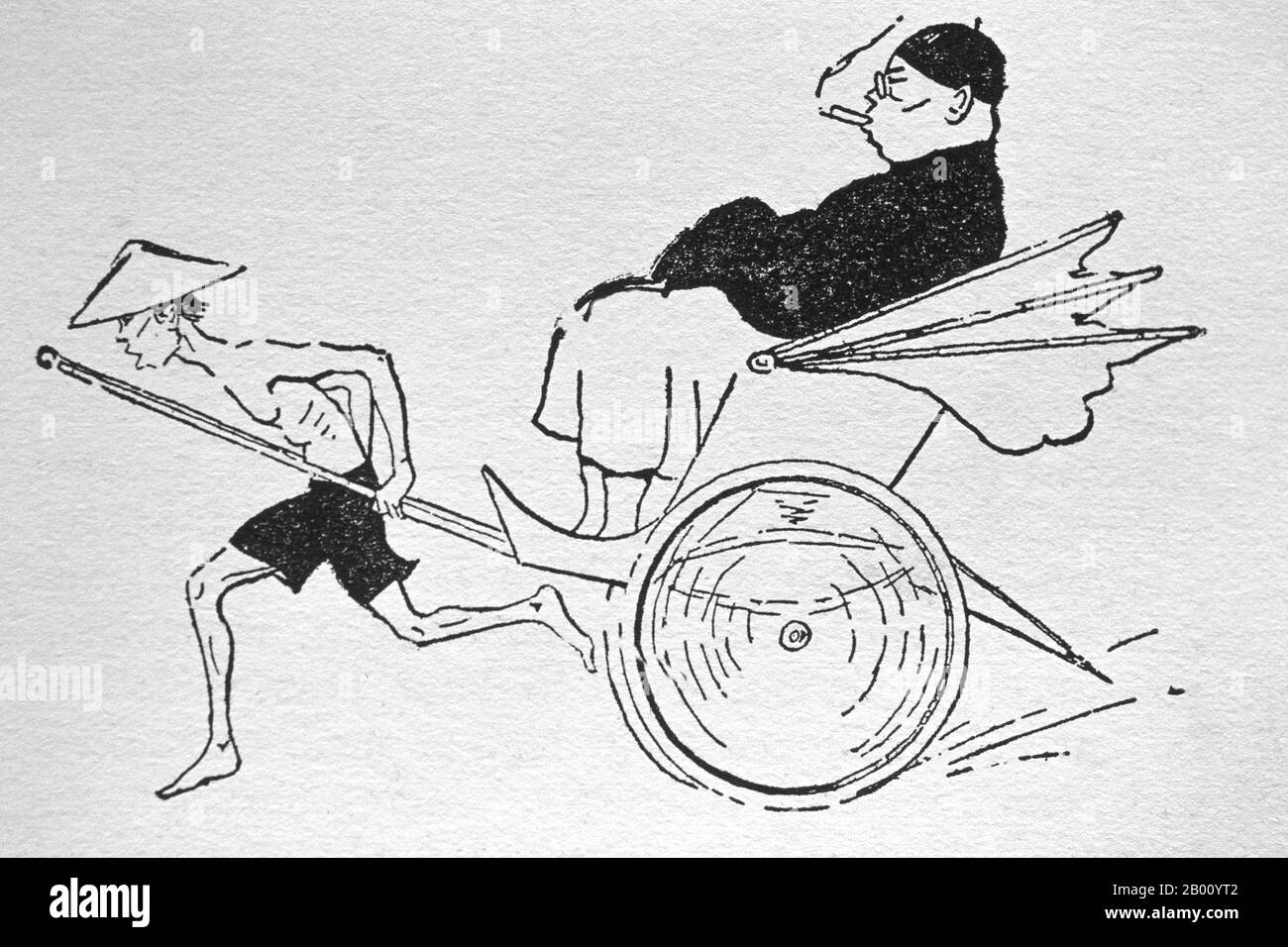 Vietnam: Drawing of a Hoa (Overseas Chinese) man being pulled in a rickshaw by a Viet coolie, Saigon, 1928. Rickshaws (or rickshas) are a mode of human-powered transport: a runner draws a two-wheeled cart which seats one or two persons. Rickshaws are commonly made with bamboo. The word rickshaw came from Asia, where they were mainly used as means of transportation for the social elite. In recent times the use of rickshaws has been discouraged or outlawed in many countries due to concern for the welfare of rickshaw workers. Stock Photohttps://www.alamy.com/image-license-details/?v=1https://www.alamy.com/vietnam-drawing-of-a-hoa-overseas-chinese-man-being-pulled-in-a-rickshaw-by-a-viet-coolie-saigon-1928-rickshaws-or-rickshas-are-a-mode-of-human-powered-transport-a-runner-draws-a-two-wheeled-cart-which-seats-one-or-two-persons-rickshaws-are-commonly-made-with-bamboo-the-word-rickshaw-came-from-asia-where-they-were-mainly-used-as-means-of-transportation-for-the-social-elite-in-recent-times-the-use-of-rickshaws-has-been-discouraged-or-outlawed-in-many-countries-due-to-concern-for-the-welfare-of-rickshaw-workers-image344229202.html
Vietnam: Drawing of a Hoa (Overseas Chinese) man being pulled in a rickshaw by a Viet coolie, Saigon, 1928. Rickshaws (or rickshas) are a mode of human-powered transport: a runner draws a two-wheeled cart which seats one or two persons. Rickshaws are commonly made with bamboo. The word rickshaw came from Asia, where they were mainly used as means of transportation for the social elite. In recent times the use of rickshaws has been discouraged or outlawed in many countries due to concern for the welfare of rickshaw workers. Stock Photohttps://www.alamy.com/image-license-details/?v=1https://www.alamy.com/vietnam-drawing-of-a-hoa-overseas-chinese-man-being-pulled-in-a-rickshaw-by-a-viet-coolie-saigon-1928-rickshaws-or-rickshas-are-a-mode-of-human-powered-transport-a-runner-draws-a-two-wheeled-cart-which-seats-one-or-two-persons-rickshaws-are-commonly-made-with-bamboo-the-word-rickshaw-came-from-asia-where-they-were-mainly-used-as-means-of-transportation-for-the-social-elite-in-recent-times-the-use-of-rickshaws-has-been-discouraged-or-outlawed-in-many-countries-due-to-concern-for-the-welfare-of-rickshaw-workers-image344229202.htmlRM2B00YT2–Vietnam: Drawing of a Hoa (Overseas Chinese) man being pulled in a rickshaw by a Viet coolie, Saigon, 1928. Rickshaws (or rickshas) are a mode of human-powered transport: a runner draws a two-wheeled cart which seats one or two persons. Rickshaws are commonly made with bamboo. The word rickshaw came from Asia, where they were mainly used as means of transportation for the social elite. In recent times the use of rickshaws has been discouraged or outlawed in many countries due to concern for the welfare of rickshaw workers.
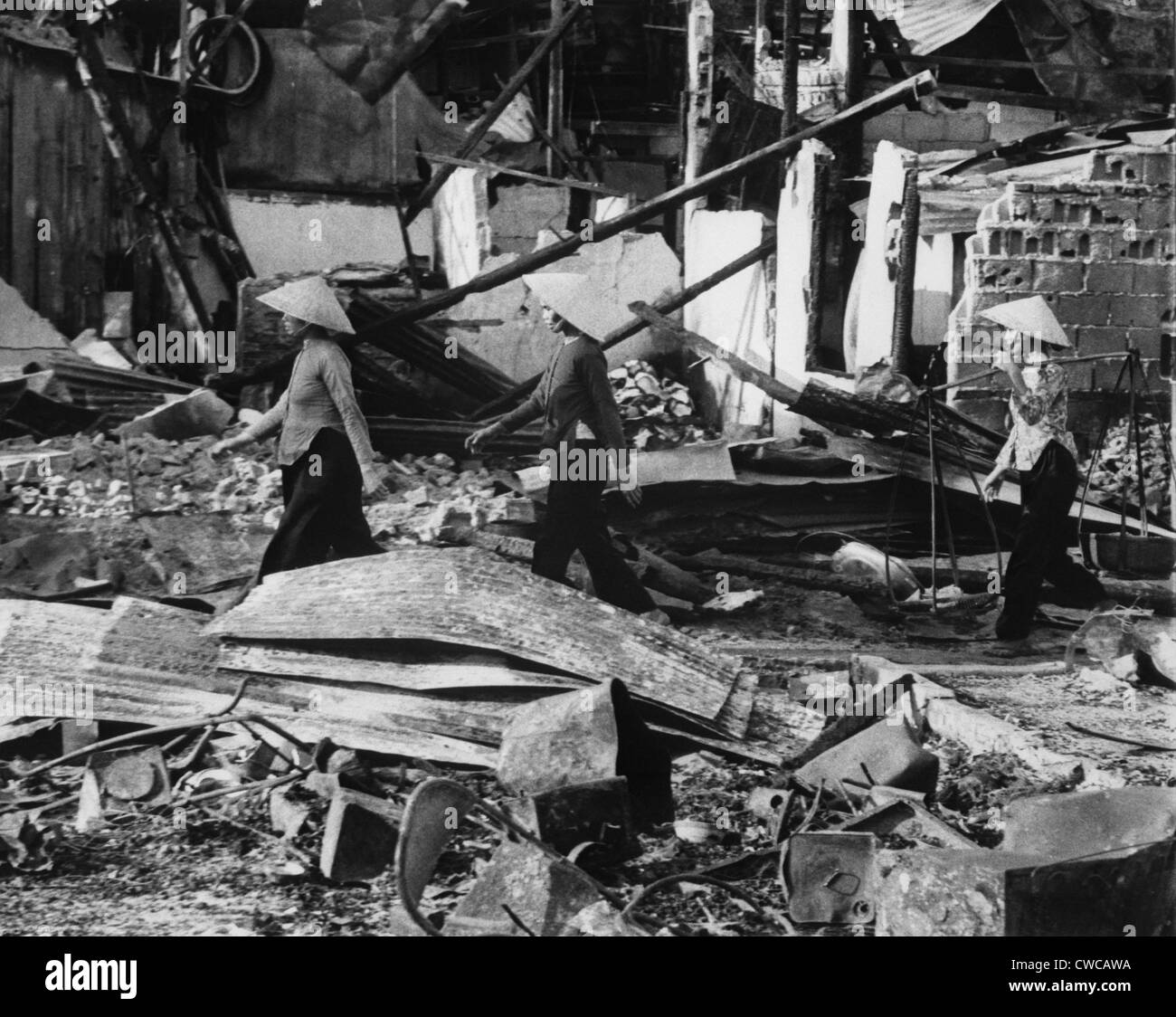 Aftermath of Tet Offensive. Three Vietnamese women return to their homes in the ruins in of the Cholon area of Saigon after a Stock Photohttps://www.alamy.com/image-license-details/?v=1https://www.alamy.com/stock-photo-aftermath-of-tet-offensive-three-vietnamese-women-return-to-their-50059110.html
Aftermath of Tet Offensive. Three Vietnamese women return to their homes in the ruins in of the Cholon area of Saigon after a Stock Photohttps://www.alamy.com/image-license-details/?v=1https://www.alamy.com/stock-photo-aftermath-of-tet-offensive-three-vietnamese-women-return-to-their-50059110.htmlRMCWCAWA–Aftermath of Tet Offensive. Three Vietnamese women return to their homes in the ruins in of the Cholon area of Saigon after a
 Chợ Lớn is a Chinese-influenced section of Ho Chi Minh City (former Saigon). It lies on the west bank of the Saigon River, having Bình Tây Market as its central market. Cholon consists of the western half of District 5 as well as several adjoining neighborhoods in District 6. The Vietnamese name Cholon literally means 'big' (lớn) 'market' (chợ). The Chinese name (and original name) of Cholon is 堤岸 (pronounced Tai-Ngon in Cantonese and Dī'àn in Mandarin, which means 'embankment' (French: quais). The Vietnamese reading of the Chinese name is Đê Ngạn, but this is rarely used. Vietnamese speakers Stock Photohttps://www.alamy.com/image-license-details/?v=1https://www.alamy.com/ch-ln-is-a-chinese-influenced-section-of-ho-chi-minh-city-former-saigon-it-lies-on-the-west-bank-of-the-saigon-river-having-bnh-ty-market-as-its-central-market-cholon-consists-of-the-western-half-of-district-5-as-well-as-several-adjoining-neighborhoods-in-district-6-the-vietnamese-name-cholon-literally-means-big-ln-market-ch-the-chinese-name-and-original-name-of-cholon-is-pronounced-tai-ngon-in-cantonese-and-dn-in-mandarin-which-means-embankment-french-quais-the-vietnamese-reading-of-the-chinese-name-is-ngn-but-this-is-rarely-used-vietnamese-speakers-image344262213.html
Chợ Lớn is a Chinese-influenced section of Ho Chi Minh City (former Saigon). It lies on the west bank of the Saigon River, having Bình Tây Market as its central market. Cholon consists of the western half of District 5 as well as several adjoining neighborhoods in District 6. The Vietnamese name Cholon literally means 'big' (lớn) 'market' (chợ). The Chinese name (and original name) of Cholon is 堤岸 (pronounced Tai-Ngon in Cantonese and Dī'àn in Mandarin, which means 'embankment' (French: quais). The Vietnamese reading of the Chinese name is Đê Ngạn, but this is rarely used. Vietnamese speakers Stock Photohttps://www.alamy.com/image-license-details/?v=1https://www.alamy.com/ch-ln-is-a-chinese-influenced-section-of-ho-chi-minh-city-former-saigon-it-lies-on-the-west-bank-of-the-saigon-river-having-bnh-ty-market-as-its-central-market-cholon-consists-of-the-western-half-of-district-5-as-well-as-several-adjoining-neighborhoods-in-district-6-the-vietnamese-name-cholon-literally-means-big-ln-market-ch-the-chinese-name-and-original-name-of-cholon-is-pronounced-tai-ngon-in-cantonese-and-dn-in-mandarin-which-means-embankment-french-quais-the-vietnamese-reading-of-the-chinese-name-is-ngn-but-this-is-rarely-used-vietnamese-speakers-image344262213.htmlRM2B02DY1–Chợ Lớn is a Chinese-influenced section of Ho Chi Minh City (former Saigon). It lies on the west bank of the Saigon River, having Bình Tây Market as its central market. Cholon consists of the western half of District 5 as well as several adjoining neighborhoods in District 6. The Vietnamese name Cholon literally means 'big' (lớn) 'market' (chợ). The Chinese name (and original name) of Cholon is 堤岸 (pronounced Tai-Ngon in Cantonese and Dī'àn in Mandarin, which means 'embankment' (French: quais). The Vietnamese reading of the Chinese name is Đê Ngạn, but this is rarely used. Vietnamese speakers
 Saigon : A Vietnamese woman lied dead in a sdeserted and battle ravaged street in the Cholon ara of Saigon 7 May 1968 after heavy fighting Stock Photohttps://www.alamy.com/image-license-details/?v=1https://www.alamy.com/saigon-a-vietnamese-woman-lied-dead-in-a-sdeserted-and-battle-ravaged-street-in-the-cholon-ara-of-saigon-7-may-1968-after-heavy-fighting-image623918917.html
Saigon : A Vietnamese woman lied dead in a sdeserted and battle ravaged street in the Cholon ara of Saigon 7 May 1968 after heavy fighting Stock Photohttps://www.alamy.com/image-license-details/?v=1https://www.alamy.com/saigon-a-vietnamese-woman-lied-dead-in-a-sdeserted-and-battle-ravaged-street-in-the-cholon-ara-of-saigon-7-may-1968-after-heavy-fighting-image623918917.htmlRM2Y71XXD–Saigon : A Vietnamese woman lied dead in a sdeserted and battle ravaged street in the Cholon ara of Saigon 7 May 1968 after heavy fighting
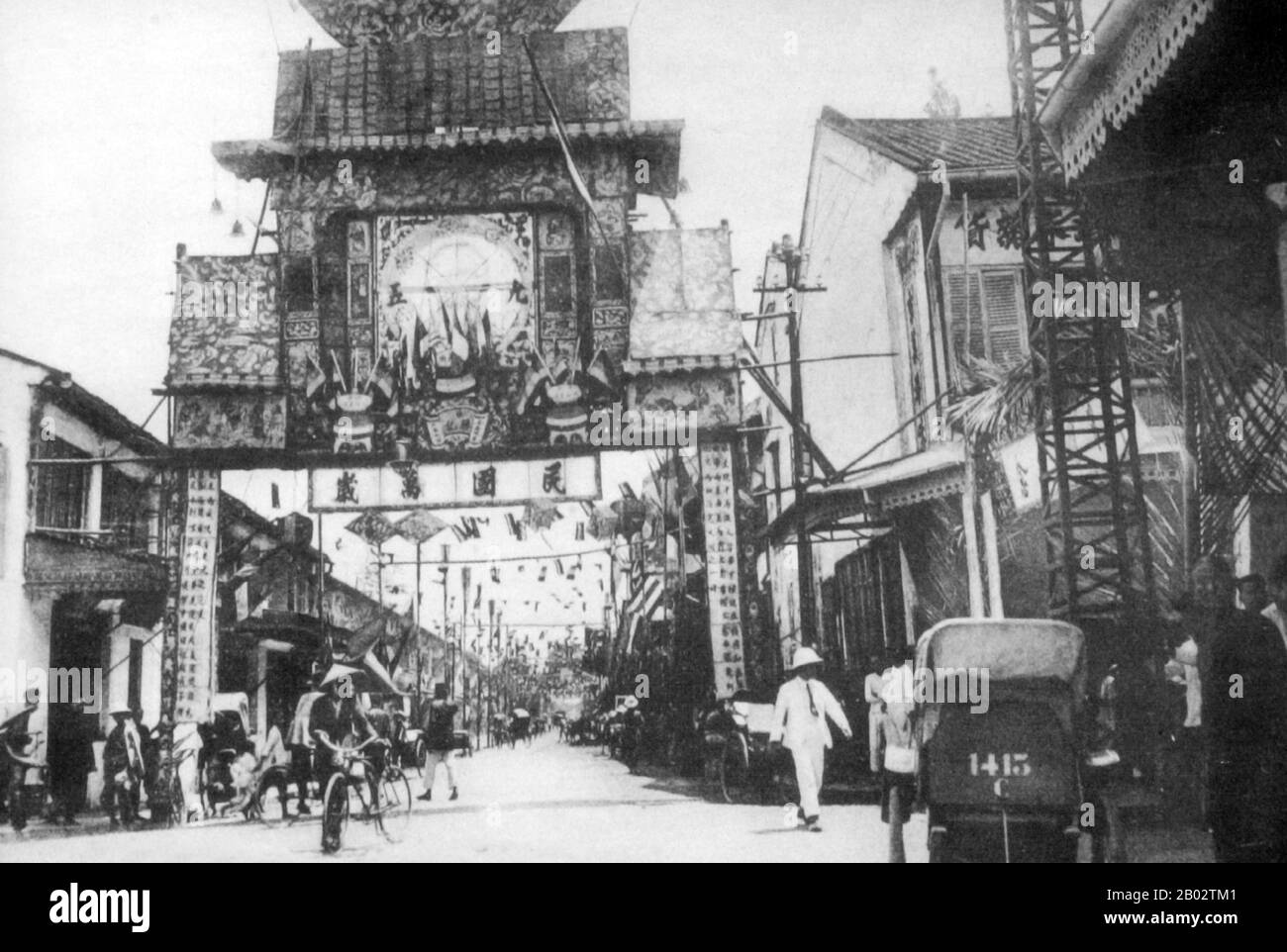 Chợ Lớn is a Chinese-influenced section of Ho Chi Minh City (former Saigon). It lies on the west bank of the Saigon River, having Bình Tây Market as its central market. Cholon consists of the western half of District 5 as well as several adjoining neighborhoods in District 6. The Vietnamese name Cholon literally means 'big' (lớn) 'market' (chợ). The Chinese name (and original name) of Cholon is 堤岸 (pronounced Tai-Ngon in Cantonese and Dī'àn in Mandarin, which means 'embankment' (French: quais). The Vietnamese reading of the Chinese name is Đê Ngạn, but this is rarely used. Vietnamese speakers Stock Photohttps://www.alamy.com/image-license-details/?v=1https://www.alamy.com/ch-ln-is-a-chinese-influenced-section-of-ho-chi-minh-city-former-saigon-it-lies-on-the-west-bank-of-the-saigon-river-having-bnh-ty-market-as-its-central-market-cholon-consists-of-the-western-half-of-district-5-as-well-as-several-adjoining-neighborhoods-in-district-6-the-vietnamese-name-cholon-literally-means-big-ln-market-ch-the-chinese-name-and-original-name-of-cholon-is-pronounced-tai-ngon-in-cantonese-and-dn-in-mandarin-which-means-embankment-french-quais-the-vietnamese-reading-of-the-chinese-name-is-ngn-but-this-is-rarely-used-vietnamese-speakers-image344270641.html
Chợ Lớn is a Chinese-influenced section of Ho Chi Minh City (former Saigon). It lies on the west bank of the Saigon River, having Bình Tây Market as its central market. Cholon consists of the western half of District 5 as well as several adjoining neighborhoods in District 6. The Vietnamese name Cholon literally means 'big' (lớn) 'market' (chợ). The Chinese name (and original name) of Cholon is 堤岸 (pronounced Tai-Ngon in Cantonese and Dī'àn in Mandarin, which means 'embankment' (French: quais). The Vietnamese reading of the Chinese name is Đê Ngạn, but this is rarely used. Vietnamese speakers Stock Photohttps://www.alamy.com/image-license-details/?v=1https://www.alamy.com/ch-ln-is-a-chinese-influenced-section-of-ho-chi-minh-city-former-saigon-it-lies-on-the-west-bank-of-the-saigon-river-having-bnh-ty-market-as-its-central-market-cholon-consists-of-the-western-half-of-district-5-as-well-as-several-adjoining-neighborhoods-in-district-6-the-vietnamese-name-cholon-literally-means-big-ln-market-ch-the-chinese-name-and-original-name-of-cholon-is-pronounced-tai-ngon-in-cantonese-and-dn-in-mandarin-which-means-embankment-french-quais-the-vietnamese-reading-of-the-chinese-name-is-ngn-but-this-is-rarely-used-vietnamese-speakers-image344270641.htmlRM2B02TM1–Chợ Lớn is a Chinese-influenced section of Ho Chi Minh City (former Saigon). It lies on the west bank of the Saigon River, having Bình Tây Market as its central market. Cholon consists of the western half of District 5 as well as several adjoining neighborhoods in District 6. The Vietnamese name Cholon literally means 'big' (lớn) 'market' (chợ). The Chinese name (and original name) of Cholon is 堤岸 (pronounced Tai-Ngon in Cantonese and Dī'àn in Mandarin, which means 'embankment' (French: quais). The Vietnamese reading of the Chinese name is Đê Ngạn, but this is rarely used. Vietnamese speakers
 15 February 1968: Siagon, South Vietnam. Communist made rockets and ammunition captured in the Cholon area of Saigon pictured with Viet Cong soldiers who were also caught on February 9th. Stock Photohttps://www.alamy.com/image-license-details/?v=1https://www.alamy.com/15-february-1968-siagon-south-vietnam-communist-made-rockets-and-ammunition-captured-in-the-cholon-area-of-saigon-pictured-with-viet-cong-soldiers-who-were-also-caught-on-february-9th-image623745643.html
15 February 1968: Siagon, South Vietnam. Communist made rockets and ammunition captured in the Cholon area of Saigon pictured with Viet Cong soldiers who were also caught on February 9th. Stock Photohttps://www.alamy.com/image-license-details/?v=1https://www.alamy.com/15-february-1968-siagon-south-vietnam-communist-made-rockets-and-ammunition-captured-in-the-cholon-area-of-saigon-pictured-with-viet-cong-soldiers-who-were-also-caught-on-february-9th-image623745643.htmlRM2Y6P1X3–15 February 1968: Siagon, South Vietnam. Communist made rockets and ammunition captured in the Cholon area of Saigon pictured with Viet Cong soldiers who were also caught on February 9th.
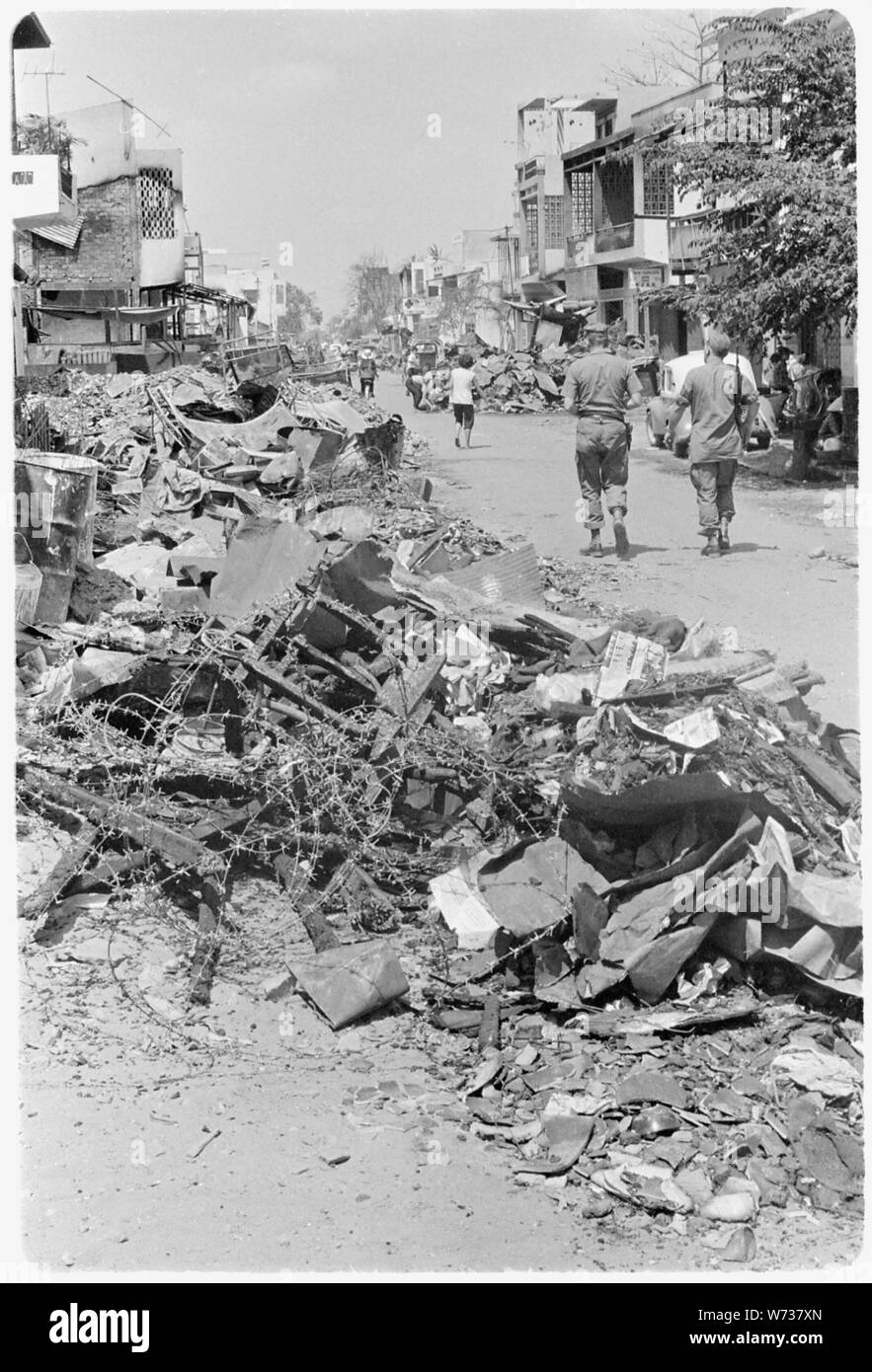 Saigon, Vietnam....Rubble and the remains of barbed wire line the streets of Cholon, a suburb of Saigon that was burned by South Vietnamese army troops in an effort to flush out any Viet Cong that remained after the Tet offensive in late January. Stock Photohttps://www.alamy.com/image-license-details/?v=1https://www.alamy.com/saigon-vietnamrubble-and-the-remains-of-barbed-wire-line-the-streets-of-cholon-a-suburb-of-saigon-that-was-burned-by-south-vietnamese-army-troops-in-an-effort-to-flush-out-any-viet-cong-that-remained-after-the-tet-offensive-in-late-january-image262530205.html
Saigon, Vietnam....Rubble and the remains of barbed wire line the streets of Cholon, a suburb of Saigon that was burned by South Vietnamese army troops in an effort to flush out any Viet Cong that remained after the Tet offensive in late January. Stock Photohttps://www.alamy.com/image-license-details/?v=1https://www.alamy.com/saigon-vietnamrubble-and-the-remains-of-barbed-wire-line-the-streets-of-cholon-a-suburb-of-saigon-that-was-burned-by-south-vietnamese-army-troops-in-an-effort-to-flush-out-any-viet-cong-that-remained-after-the-tet-offensive-in-late-january-image262530205.htmlRMW737XN–Saigon, Vietnam....Rubble and the remains of barbed wire line the streets of Cholon, a suburb of Saigon that was burned by South Vietnamese army troops in an effort to flush out any Viet Cong that remained after the Tet offensive in late January.
 Saigon : A US soldier calls for air support as battles raged in the Cholon district fo Saigon on 7 may . Smoke in the background comes from one of many buildings set alight during the fierce fighting . 11 May 1968 Stock Photohttps://www.alamy.com/image-license-details/?v=1https://www.alamy.com/saigon-a-us-soldier-calls-for-air-support-as-battles-raged-in-the-cholon-district-fo-saigon-on-7-may-smoke-in-the-background-comes-from-one-of-many-buildings-set-alight-during-the-fierce-fighting-11-may-1968-image623918887.html
Saigon : A US soldier calls for air support as battles raged in the Cholon district fo Saigon on 7 may . Smoke in the background comes from one of many buildings set alight during the fierce fighting . 11 May 1968 Stock Photohttps://www.alamy.com/image-license-details/?v=1https://www.alamy.com/saigon-a-us-soldier-calls-for-air-support-as-battles-raged-in-the-cholon-district-fo-saigon-on-7-may-smoke-in-the-background-comes-from-one-of-many-buildings-set-alight-during-the-fierce-fighting-11-may-1968-image623918887.htmlRM2Y71XWB–Saigon : A US soldier calls for air support as battles raged in the Cholon district fo Saigon on 7 may . Smoke in the background comes from one of many buildings set alight during the fierce fighting . 11 May 1968
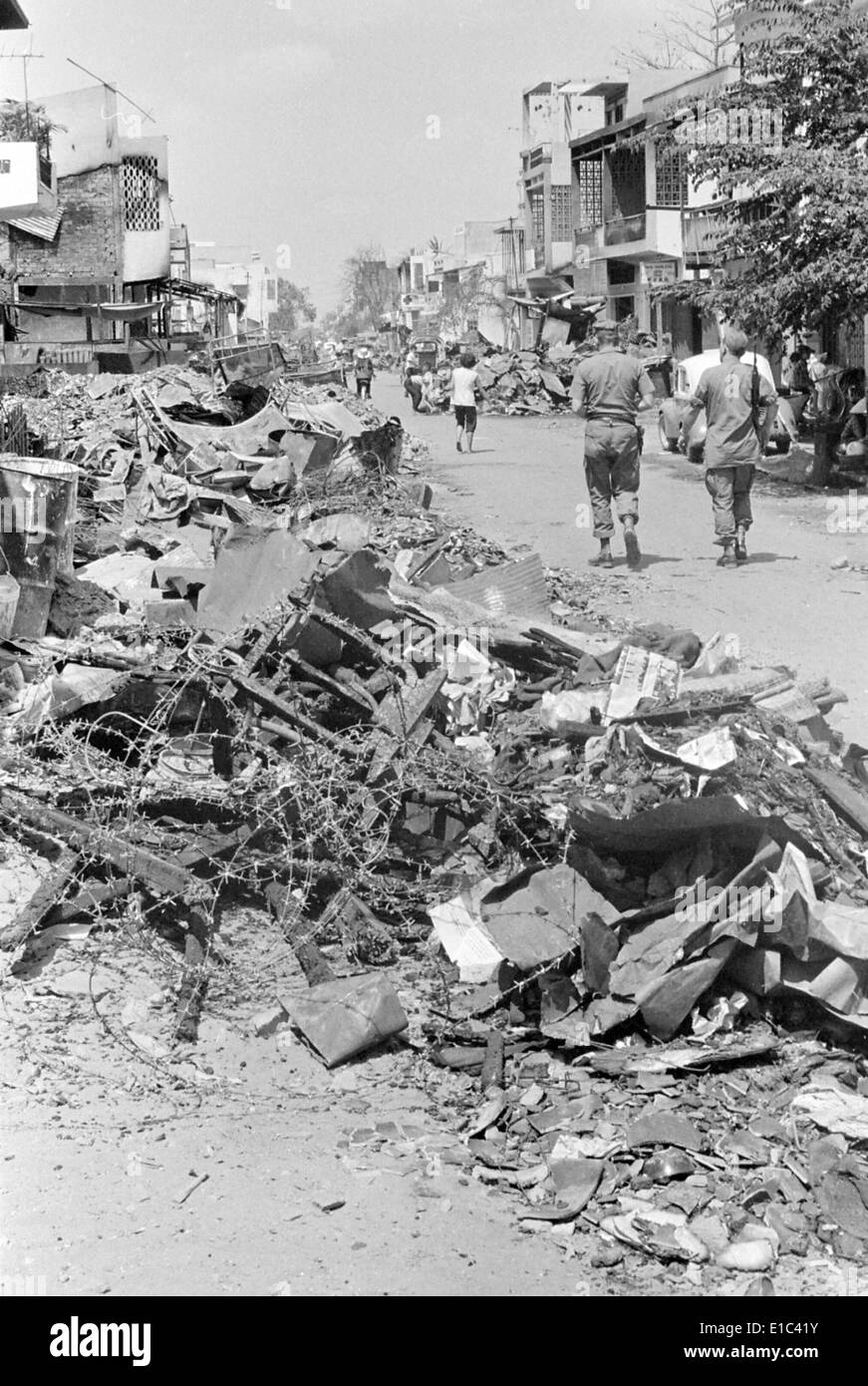 Vietnam War, Saigon, Vietnam, rubble and the remains of barbed wire line the streets of Cholon, a suburb of Saigon that was Stock Photohttps://www.alamy.com/image-license-details/?v=1https://www.alamy.com/vietnam-war-saigon-vietnam-rubble-and-the-remains-of-barbed-wire-line-image69722743.html
Vietnam War, Saigon, Vietnam, rubble and the remains of barbed wire line the streets of Cholon, a suburb of Saigon that was Stock Photohttps://www.alamy.com/image-license-details/?v=1https://www.alamy.com/vietnam-war-saigon-vietnam-rubble-and-the-remains-of-barbed-wire-line-image69722743.htmlRME1C41Y–Vietnam War, Saigon, Vietnam, rubble and the remains of barbed wire line the streets of Cholon, a suburb of Saigon that was
 Saigon: Outnumbered South Vietnamese rangers advance through the burning Cholon sector of the South Vietnamese capital as fierce fighting continued . An enemy attempt to overrun their positions led to action near the racetrack . Viet Cong guerillas set fire to a block of houses in the area , and held off a South Vietnamese battalion trying to take the area . 6 May 1968 Stock Photohttps://www.alamy.com/image-license-details/?v=1https://www.alamy.com/saigon-outnumbered-south-vietnamese-rangers-advance-through-the-burning-cholon-sector-of-the-south-vietnamese-capital-as-fierce-fighting-continued-an-enemy-attempt-to-overrun-their-positions-led-to-action-near-the-racetrack-viet-cong-guerillas-set-fire-to-a-block-of-houses-in-the-area-and-held-off-a-south-vietnamese-battalion-trying-to-take-the-area-6-may-1968-image623918894.html
Saigon: Outnumbered South Vietnamese rangers advance through the burning Cholon sector of the South Vietnamese capital as fierce fighting continued . An enemy attempt to overrun their positions led to action near the racetrack . Viet Cong guerillas set fire to a block of houses in the area , and held off a South Vietnamese battalion trying to take the area . 6 May 1968 Stock Photohttps://www.alamy.com/image-license-details/?v=1https://www.alamy.com/saigon-outnumbered-south-vietnamese-rangers-advance-through-the-burning-cholon-sector-of-the-south-vietnamese-capital-as-fierce-fighting-continued-an-enemy-attempt-to-overrun-their-positions-led-to-action-near-the-racetrack-viet-cong-guerillas-set-fire-to-a-block-of-houses-in-the-area-and-held-off-a-south-vietnamese-battalion-trying-to-take-the-area-6-may-1968-image623918894.htmlRM2Y71XWJ–Saigon: Outnumbered South Vietnamese rangers advance through the burning Cholon sector of the South Vietnamese capital as fierce fighting continued . An enemy attempt to overrun their positions led to action near the racetrack . Viet Cong guerillas set fire to a block of houses in the area , and held off a South Vietnamese battalion trying to take the area . 6 May 1968
 Aftermath of Tet Offensive. Three Vietnamese women return to their homes in the ruins in of the Cholon area of Saigon after a Stock Photohttps://www.alamy.com/image-license-details/?v=1https://www.alamy.com/stock-photo-aftermath-of-tet-offensive-three-vietnamese-women-return-to-their-48040261.html
Aftermath of Tet Offensive. Three Vietnamese women return to their homes in the ruins in of the Cholon area of Saigon after a Stock Photohttps://www.alamy.com/image-license-details/?v=1https://www.alamy.com/stock-photo-aftermath-of-tet-offensive-three-vietnamese-women-return-to-their-48040261.htmlRMCP4BRH–Aftermath of Tet Offensive. Three Vietnamese women return to their homes in the ruins in of the Cholon area of Saigon after a
 Saigon : Ta Thai Manh , at the age of 15 is the youngest member of Vietnamese Rangers and he smokes a cigarette as he waits for transportation to take him to an aid station after he was wounded in action in the Cholon section of Saigon 6 May 1968 . The youngster has another distinction besides his age : in March he was given a medal for helping capture seven Viet Cong . 7 May 1968 Stock Photohttps://www.alamy.com/image-license-details/?v=1https://www.alamy.com/saigon-ta-thai-manh-at-the-age-of-15-is-the-youngest-member-of-vietnamese-rangers-and-he-smokes-a-cigarette-as-he-waits-for-transportation-to-take-him-to-an-aid-station-after-he-was-wounded-in-action-in-the-cholon-section-of-saigon-6-may-1968-the-youngster-has-another-distinction-besides-his-age-in-march-he-was-given-a-medal-for-helping-capture-seven-viet-cong-7-may-1968-image623918903.html
Saigon : Ta Thai Manh , at the age of 15 is the youngest member of Vietnamese Rangers and he smokes a cigarette as he waits for transportation to take him to an aid station after he was wounded in action in the Cholon section of Saigon 6 May 1968 . The youngster has another distinction besides his age : in March he was given a medal for helping capture seven Viet Cong . 7 May 1968 Stock Photohttps://www.alamy.com/image-license-details/?v=1https://www.alamy.com/saigon-ta-thai-manh-at-the-age-of-15-is-the-youngest-member-of-vietnamese-rangers-and-he-smokes-a-cigarette-as-he-waits-for-transportation-to-take-him-to-an-aid-station-after-he-was-wounded-in-action-in-the-cholon-section-of-saigon-6-may-1968-the-youngster-has-another-distinction-besides-his-age-in-march-he-was-given-a-medal-for-helping-capture-seven-viet-cong-7-may-1968-image623918903.htmlRM2Y71XWY–Saigon : Ta Thai Manh , at the age of 15 is the youngest member of Vietnamese Rangers and he smokes a cigarette as he waits for transportation to take him to an aid station after he was wounded in action in the Cholon section of Saigon 6 May 1968 . The youngster has another distinction besides his age : in March he was given a medal for helping capture seven Viet Cong . 7 May 1968
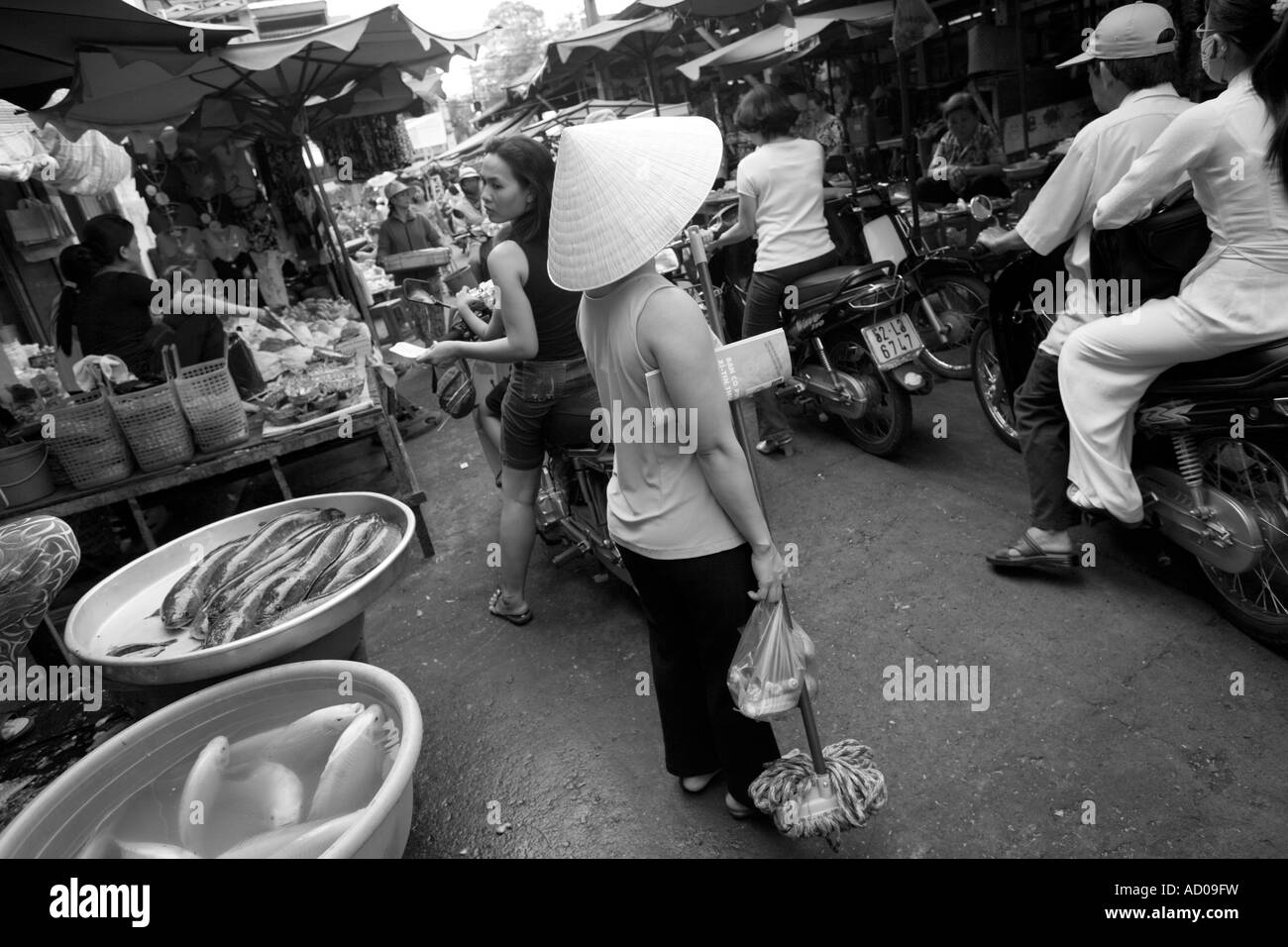 Southeast Asia Vietnam Ho Chi Minh City Crowded market of street vendors in Saigons Cholon Chinatown District Stock Photohttps://www.alamy.com/image-license-details/?v=1https://www.alamy.com/stock-photo-southeast-asia-vietnam-ho-chi-minh-city-crowded-market-of-street-vendors-13262220.html
Southeast Asia Vietnam Ho Chi Minh City Crowded market of street vendors in Saigons Cholon Chinatown District Stock Photohttps://www.alamy.com/image-license-details/?v=1https://www.alamy.com/stock-photo-southeast-asia-vietnam-ho-chi-minh-city-crowded-market-of-street-vendors-13262220.htmlRMAD09FW–Southeast Asia Vietnam Ho Chi Minh City Crowded market of street vendors in Saigons Cholon Chinatown District
 Saigon: A mushroom-shaped cloud of smoke rises from the burning Cholon sector of the city of Saigon , scene of some of the heaviest fighting and destruction in the current 'peace talks ' offensive of the Communists. In the foreground is a military cemetery with row upon row of graves. It is near the site of the Tun Son Nhut airbase just outside the city . A South Vietnames solder (Left) continues on his way . 9 May 1968 Stock Photohttps://www.alamy.com/image-license-details/?v=1https://www.alamy.com/saigon-a-mushroom-shaped-cloud-of-smoke-rises-from-the-burning-cholon-sector-of-the-city-of-saigon-scene-of-some-of-the-heaviest-fighting-and-destruction-in-the-current-peace-talks-offensive-of-the-communists-in-the-foreground-is-a-military-cemetery-with-row-upon-row-of-graves-it-is-near-the-site-of-the-tun-son-nhut-airbase-just-outside-the-city-a-south-vietnames-solder-left-continues-on-his-way-9-may-1968-image623918905.html
Saigon: A mushroom-shaped cloud of smoke rises from the burning Cholon sector of the city of Saigon , scene of some of the heaviest fighting and destruction in the current 'peace talks ' offensive of the Communists. In the foreground is a military cemetery with row upon row of graves. It is near the site of the Tun Son Nhut airbase just outside the city . A South Vietnames solder (Left) continues on his way . 9 May 1968 Stock Photohttps://www.alamy.com/image-license-details/?v=1https://www.alamy.com/saigon-a-mushroom-shaped-cloud-of-smoke-rises-from-the-burning-cholon-sector-of-the-city-of-saigon-scene-of-some-of-the-heaviest-fighting-and-destruction-in-the-current-peace-talks-offensive-of-the-communists-in-the-foreground-is-a-military-cemetery-with-row-upon-row-of-graves-it-is-near-the-site-of-the-tun-son-nhut-airbase-just-outside-the-city-a-south-vietnames-solder-left-continues-on-his-way-9-may-1968-image623918905.htmlRM2Y71XX1–Saigon: A mushroom-shaped cloud of smoke rises from the burning Cholon sector of the city of Saigon , scene of some of the heaviest fighting and destruction in the current 'peace talks ' offensive of the Communists. In the foreground is a military cemetery with row upon row of graves. It is near the site of the Tun Son Nhut airbase just outside the city . A South Vietnames solder (Left) continues on his way . 9 May 1968
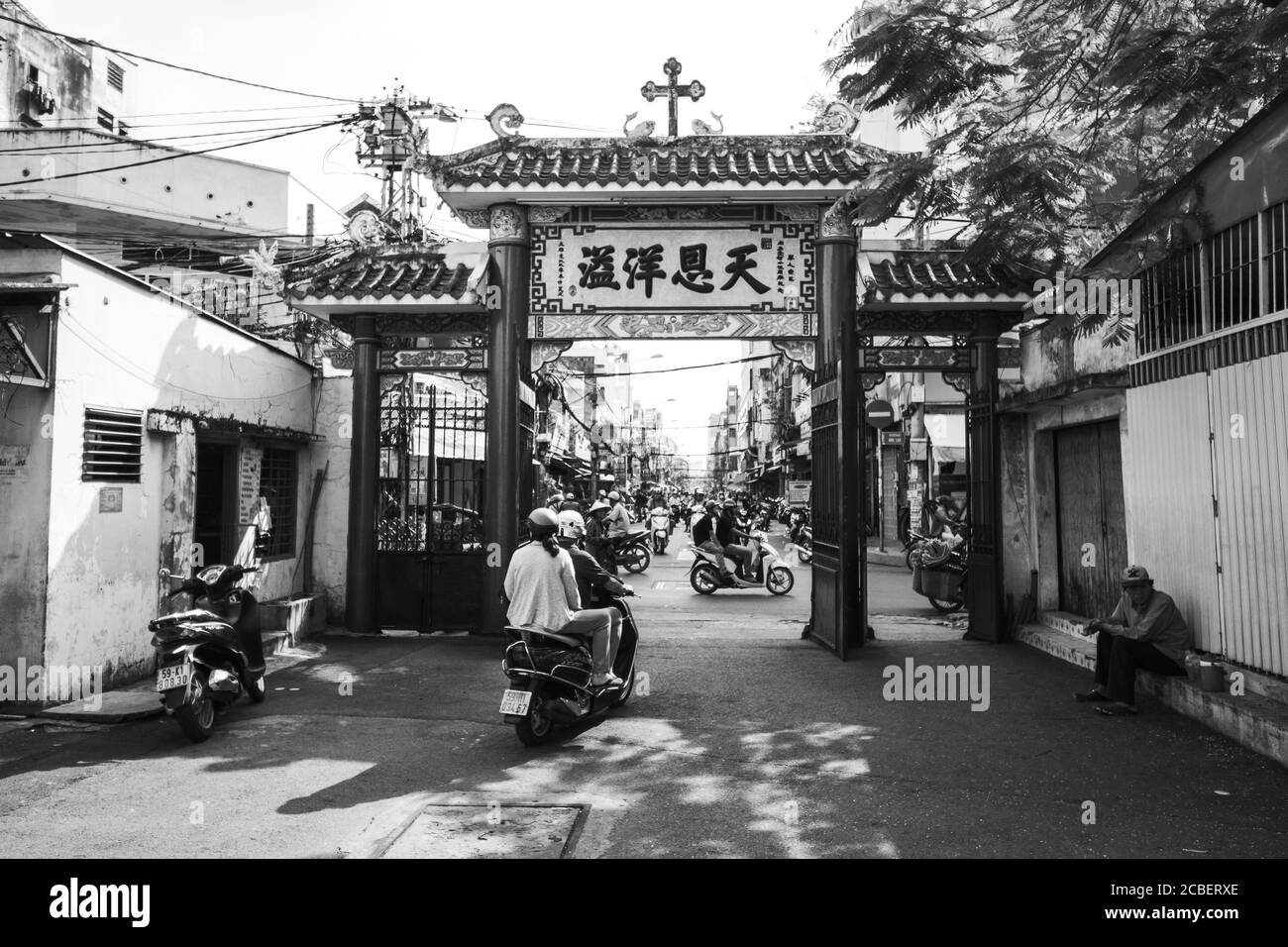 HO-CHI-MINH-CITY, VIETNAM - Nov 13, 2019: The entrance gate to the territory of Cha Tam Church (St. Francis Xavier Parish Church). A must-see of Cho L Stock Photohttps://www.alamy.com/image-license-details/?v=1https://www.alamy.com/ho-chi-minh-city-vietnam-nov-13-2019-the-entrance-gate-to-the-territory-of-cha-tam-church-st-francis-xavier-parish-church-a-must-see-of-cho-l-image368505046.html
HO-CHI-MINH-CITY, VIETNAM - Nov 13, 2019: The entrance gate to the territory of Cha Tam Church (St. Francis Xavier Parish Church). A must-see of Cho L Stock Photohttps://www.alamy.com/image-license-details/?v=1https://www.alamy.com/ho-chi-minh-city-vietnam-nov-13-2019-the-entrance-gate-to-the-territory-of-cha-tam-church-st-francis-xavier-parish-church-a-must-see-of-cho-l-image368505046.htmlRF2CBERXE–HO-CHI-MINH-CITY, VIETNAM - Nov 13, 2019: The entrance gate to the territory of Cha Tam Church (St. Francis Xavier Parish Church). A must-see of Cho L
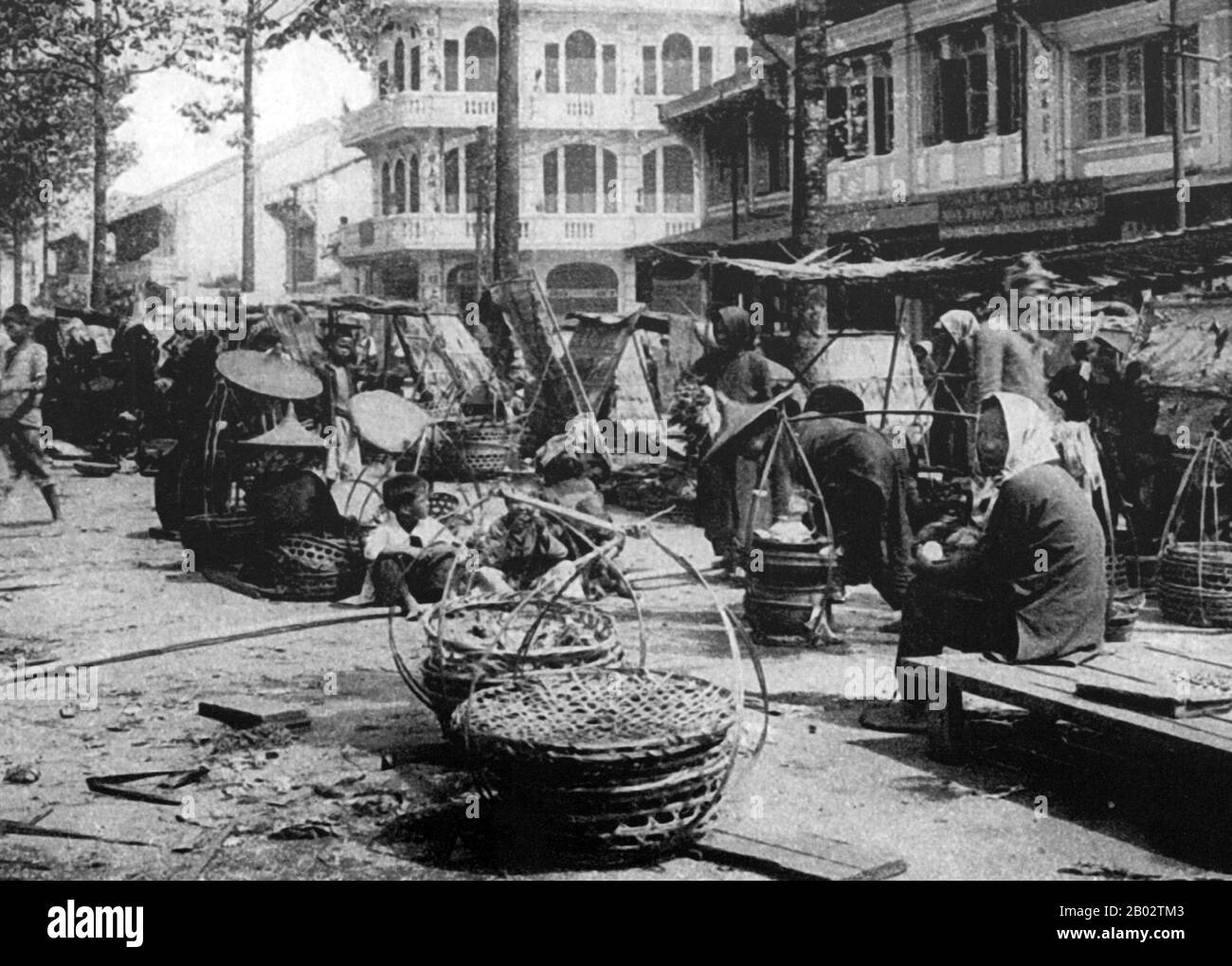 Chợ Lớn is a Chinese-influenced section of Ho Chi Minh City (former Saigon). It lies on the west bank of the Saigon River, having Bình Tây Market as its central market. Cholon consists of the western half of District 5 as well as several adjoining neighborhoods in District 6. The Vietnamese name Cholon literally means 'big' (lớn) 'market' (chợ). The Chinese name (and original name) of Cholon is 堤岸 (pronounced Tai-Ngon in Cantonese and Dī'àn in Mandarin, which means 'embankment' (French: quais). The Vietnamese reading of the Chinese name is Đê Ngạn, but this is rarely used. Vietnamese speakers Stock Photohttps://www.alamy.com/image-license-details/?v=1https://www.alamy.com/ch-ln-is-a-chinese-influenced-section-of-ho-chi-minh-city-former-saigon-it-lies-on-the-west-bank-of-the-saigon-river-having-bnh-ty-market-as-its-central-market-cholon-consists-of-the-western-half-of-district-5-as-well-as-several-adjoining-neighborhoods-in-district-6-the-vietnamese-name-cholon-literally-means-big-ln-market-ch-the-chinese-name-and-original-name-of-cholon-is-pronounced-tai-ngon-in-cantonese-and-dn-in-mandarin-which-means-embankment-french-quais-the-vietnamese-reading-of-the-chinese-name-is-ngn-but-this-is-rarely-used-vietnamese-speakers-image344270643.html
Chợ Lớn is a Chinese-influenced section of Ho Chi Minh City (former Saigon). It lies on the west bank of the Saigon River, having Bình Tây Market as its central market. Cholon consists of the western half of District 5 as well as several adjoining neighborhoods in District 6. The Vietnamese name Cholon literally means 'big' (lớn) 'market' (chợ). The Chinese name (and original name) of Cholon is 堤岸 (pronounced Tai-Ngon in Cantonese and Dī'àn in Mandarin, which means 'embankment' (French: quais). The Vietnamese reading of the Chinese name is Đê Ngạn, but this is rarely used. Vietnamese speakers Stock Photohttps://www.alamy.com/image-license-details/?v=1https://www.alamy.com/ch-ln-is-a-chinese-influenced-section-of-ho-chi-minh-city-former-saigon-it-lies-on-the-west-bank-of-the-saigon-river-having-bnh-ty-market-as-its-central-market-cholon-consists-of-the-western-half-of-district-5-as-well-as-several-adjoining-neighborhoods-in-district-6-the-vietnamese-name-cholon-literally-means-big-ln-market-ch-the-chinese-name-and-original-name-of-cholon-is-pronounced-tai-ngon-in-cantonese-and-dn-in-mandarin-which-means-embankment-french-quais-the-vietnamese-reading-of-the-chinese-name-is-ngn-but-this-is-rarely-used-vietnamese-speakers-image344270643.htmlRM2B02TM3–Chợ Lớn is a Chinese-influenced section of Ho Chi Minh City (former Saigon). It lies on the west bank of the Saigon River, having Bình Tây Market as its central market. Cholon consists of the western half of District 5 as well as several adjoining neighborhoods in District 6. The Vietnamese name Cholon literally means 'big' (lớn) 'market' (chợ). The Chinese name (and original name) of Cholon is 堤岸 (pronounced Tai-Ngon in Cantonese and Dī'àn in Mandarin, which means 'embankment' (French: quais). The Vietnamese reading of the Chinese name is Đê Ngạn, but this is rarely used. Vietnamese speakers
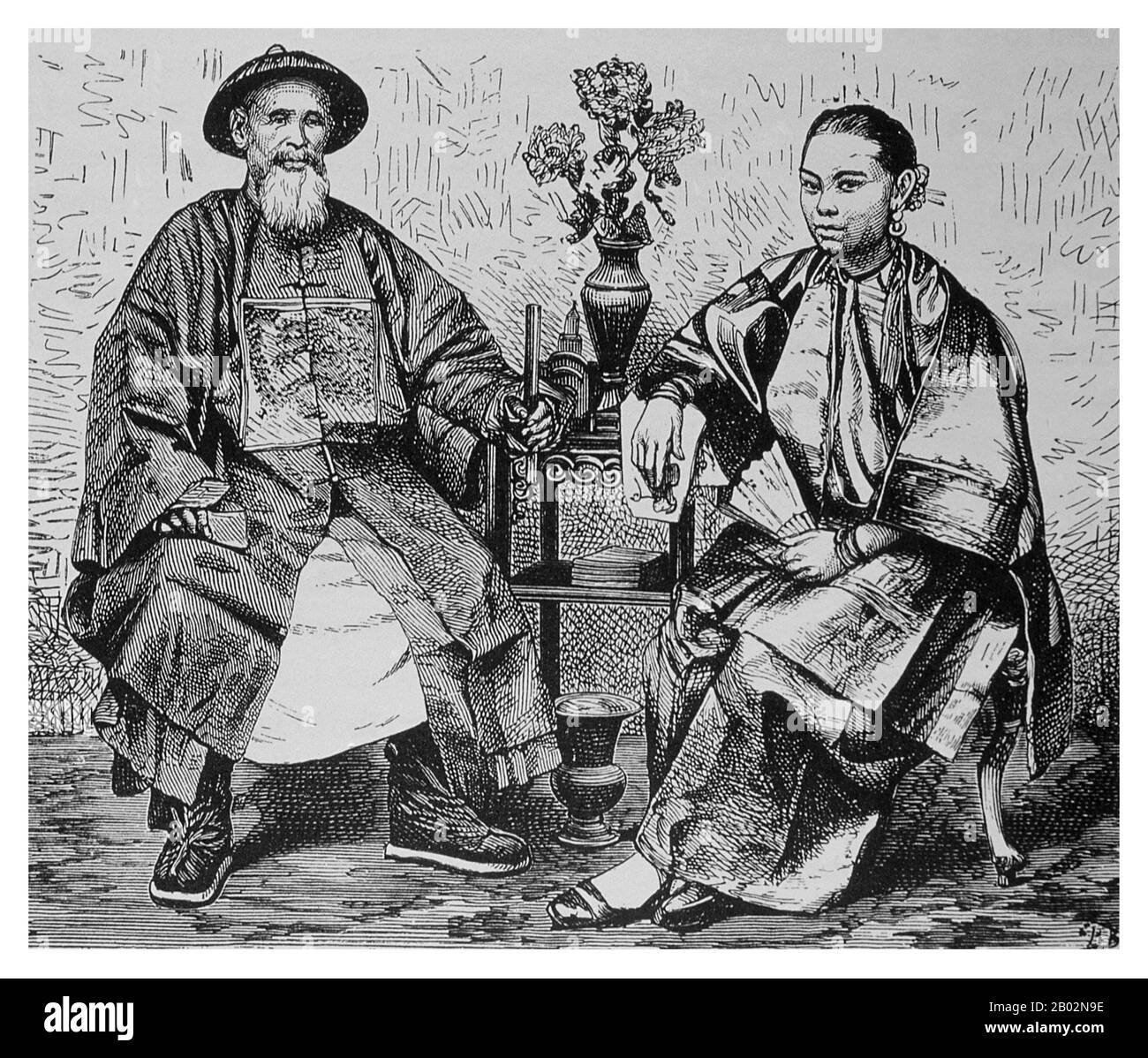 Chợ Lớn is a Chinese-influenced section of Ho Chi Minh City (former Saigon). It lies on the west bank of the Saigon River, having Bình Tây Market as its central market. Cholon consists of the western half of District 5 as well as several adjoining neighborhoods in District 6. The Vietnamese name Cholon literally means 'big' (lớn) 'market' (chợ). The Chinese name (and original name) of Cholon is 堤岸 (pronounced Tai-Ngon in Cantonese and Dī'àn in Mandarin, which means 'embankment' (French: quais). The Vietnamese reading of the Chinese name is Đê Ngạn, but this is rarely used. Vietnamese speakers Stock Photohttps://www.alamy.com/image-license-details/?v=1https://www.alamy.com/ch-ln-is-a-chinese-influenced-section-of-ho-chi-minh-city-former-saigon-it-lies-on-the-west-bank-of-the-saigon-river-having-bnh-ty-market-as-its-central-market-cholon-consists-of-the-western-half-of-district-5-as-well-as-several-adjoining-neighborhoods-in-district-6-the-vietnamese-name-cholon-literally-means-big-ln-market-ch-the-chinese-name-and-original-name-of-cholon-is-pronounced-tai-ngon-in-cantonese-and-dn-in-mandarin-which-means-embankment-french-quais-the-vietnamese-reading-of-the-chinese-name-is-ngn-but-this-is-rarely-used-vietnamese-speakers-image344267994.html
Chợ Lớn is a Chinese-influenced section of Ho Chi Minh City (former Saigon). It lies on the west bank of the Saigon River, having Bình Tây Market as its central market. Cholon consists of the western half of District 5 as well as several adjoining neighborhoods in District 6. The Vietnamese name Cholon literally means 'big' (lớn) 'market' (chợ). The Chinese name (and original name) of Cholon is 堤岸 (pronounced Tai-Ngon in Cantonese and Dī'àn in Mandarin, which means 'embankment' (French: quais). The Vietnamese reading of the Chinese name is Đê Ngạn, but this is rarely used. Vietnamese speakers Stock Photohttps://www.alamy.com/image-license-details/?v=1https://www.alamy.com/ch-ln-is-a-chinese-influenced-section-of-ho-chi-minh-city-former-saigon-it-lies-on-the-west-bank-of-the-saigon-river-having-bnh-ty-market-as-its-central-market-cholon-consists-of-the-western-half-of-district-5-as-well-as-several-adjoining-neighborhoods-in-district-6-the-vietnamese-name-cholon-literally-means-big-ln-market-ch-the-chinese-name-and-original-name-of-cholon-is-pronounced-tai-ngon-in-cantonese-and-dn-in-mandarin-which-means-embankment-french-quais-the-vietnamese-reading-of-the-chinese-name-is-ngn-but-this-is-rarely-used-vietnamese-speakers-image344267994.htmlRM2B02N9E–Chợ Lớn is a Chinese-influenced section of Ho Chi Minh City (former Saigon). It lies on the west bank of the Saigon River, having Bình Tây Market as its central market. Cholon consists of the western half of District 5 as well as several adjoining neighborhoods in District 6. The Vietnamese name Cholon literally means 'big' (lớn) 'market' (chợ). The Chinese name (and original name) of Cholon is 堤岸 (pronounced Tai-Ngon in Cantonese and Dī'àn in Mandarin, which means 'embankment' (French: quais). The Vietnamese reading of the Chinese name is Đê Ngạn, but this is rarely used. Vietnamese speakers
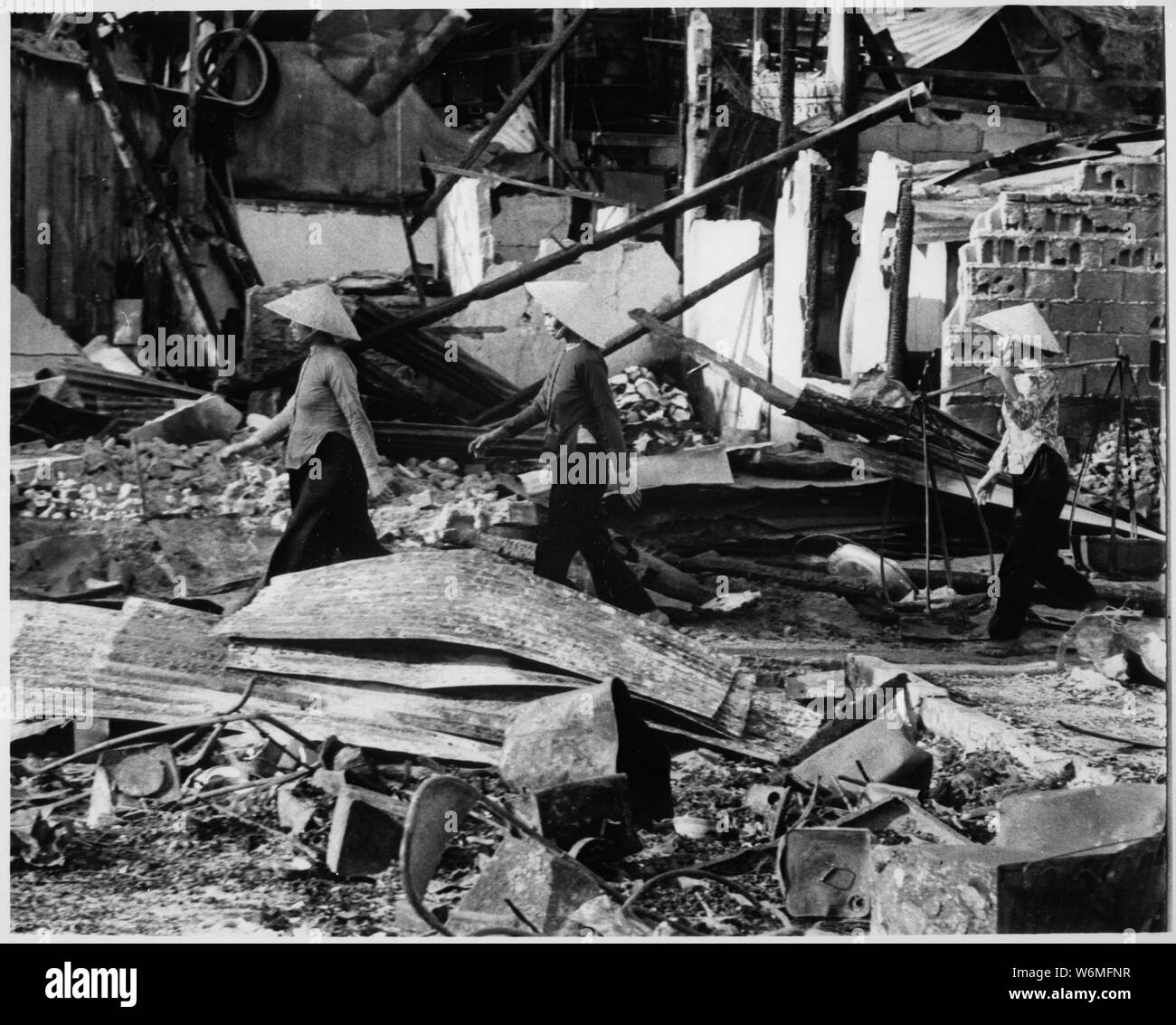 Three Vietnamese women move back into the Cholon area after Viet Cong attack that left a two-block area leveled, in hopes of salvaging meager belongings. Saigon, January 31, 1968., 1958 - 1974; General notes: Use War and Conflict Number 421 when ordering a reproduction or requesting information about this image. Stock Photohttps://www.alamy.com/image-license-details/?v=1https://www.alamy.com/three-vietnamese-women-move-back-into-the-cholon-area-after-viet-cong-attack-that-left-a-two-block-area-leveled-in-hopes-of-salvaging-meager-belongings-saigon-january-31-1968-1958-1974-general-notes-use-war-and-conflict-number-421-when-ordering-a-reproduction-or-requesting-information-about-this-image-image262294867.html
Three Vietnamese women move back into the Cholon area after Viet Cong attack that left a two-block area leveled, in hopes of salvaging meager belongings. Saigon, January 31, 1968., 1958 - 1974; General notes: Use War and Conflict Number 421 when ordering a reproduction or requesting information about this image. Stock Photohttps://www.alamy.com/image-license-details/?v=1https://www.alamy.com/three-vietnamese-women-move-back-into-the-cholon-area-after-viet-cong-attack-that-left-a-two-block-area-leveled-in-hopes-of-salvaging-meager-belongings-saigon-january-31-1968-1958-1974-general-notes-use-war-and-conflict-number-421-when-ordering-a-reproduction-or-requesting-information-about-this-image-image262294867.htmlRMW6MFNR–Three Vietnamese women move back into the Cholon area after Viet Cong attack that left a two-block area leveled, in hopes of salvaging meager belongings. Saigon, January 31, 1968., 1958 - 1974; General notes: Use War and Conflict Number 421 when ordering a reproduction or requesting information about this image.
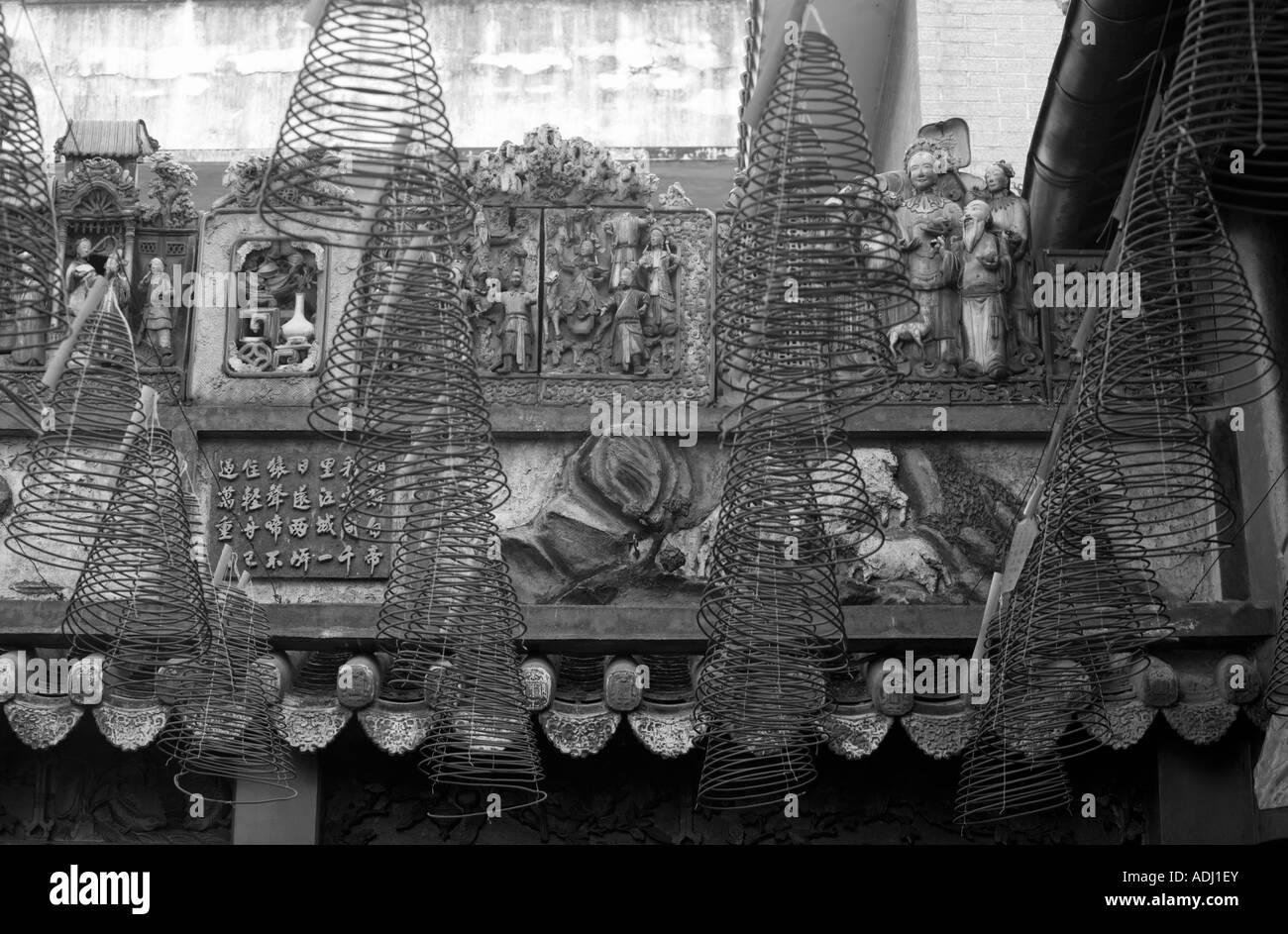 Southeast Asia Vietnam Ho Chi Minh City Incense coils burn in clouds of smoke inside Thien Hau Pagod Stock Photohttps://www.alamy.com/image-license-details/?v=1https://www.alamy.com/stock-photo-southeast-asia-vietnam-ho-chi-minh-city-incense-coils-burn-in-clouds-13428866.html
Southeast Asia Vietnam Ho Chi Minh City Incense coils burn in clouds of smoke inside Thien Hau Pagod Stock Photohttps://www.alamy.com/image-license-details/?v=1https://www.alamy.com/stock-photo-southeast-asia-vietnam-ho-chi-minh-city-incense-coils-burn-in-clouds-13428866.htmlRMADJ1EY–Southeast Asia Vietnam Ho Chi Minh City Incense coils burn in clouds of smoke inside Thien Hau Pagod
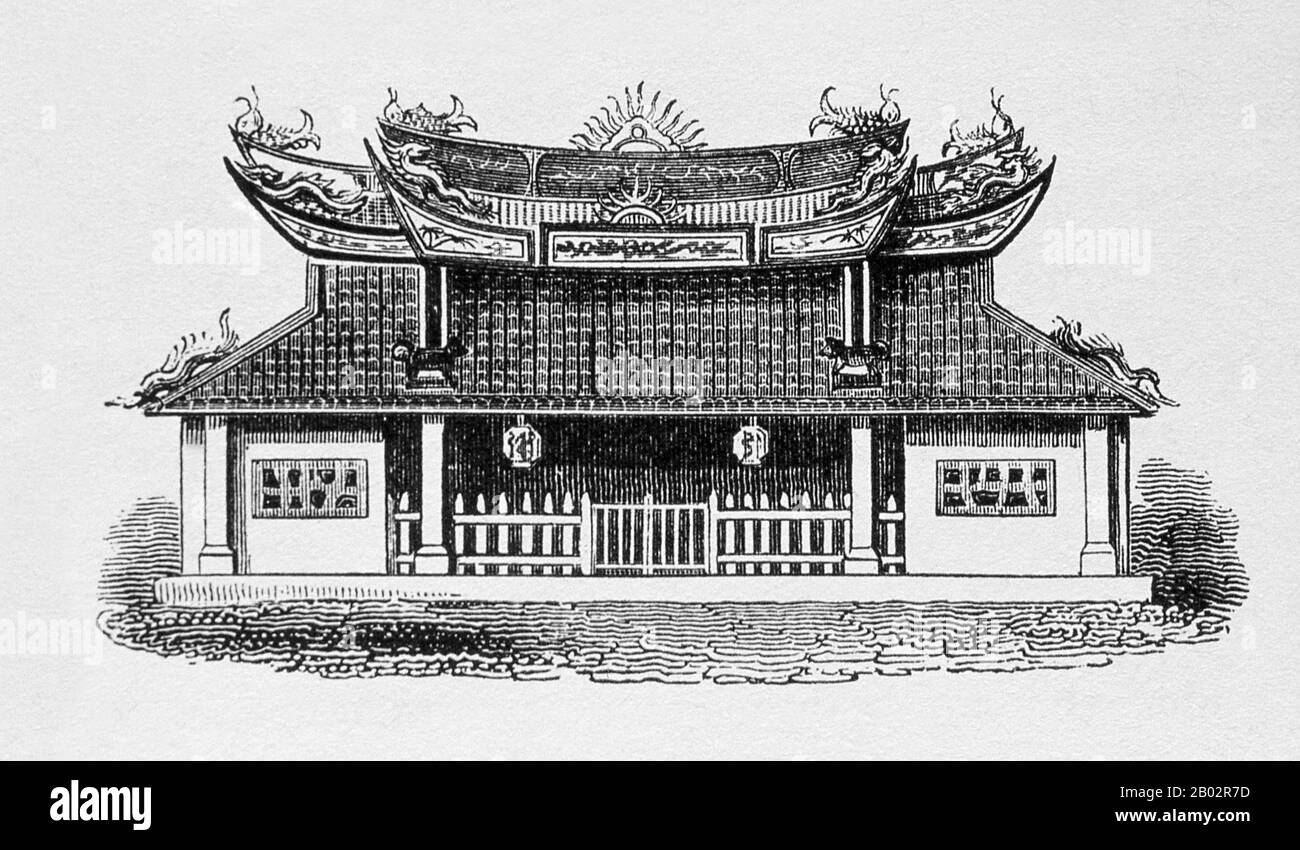 Chợ Lớn is a Chinese-influenced section of Ho Chi Minh City (former Saigon). It lies on the west bank of the Saigon River, having Bình Tây Market as its central market. Cholon consists of the western half of District 5 as well as several adjoining neighborhoods in District 6. The Vietnamese name Cholon literally means 'big' (lớn) 'market' (chợ). The Chinese name (and original name) of Cholon is 堤岸 (pronounced Tai-Ngon in Cantonese and Dī'àn in Mandarin, which means 'embankment' (French: quais). The Vietnamese reading of the Chinese name is Đê Ngạn, but this is rarely used. Vietnamese speakers Stock Photohttps://www.alamy.com/image-license-details/?v=1https://www.alamy.com/ch-ln-is-a-chinese-influenced-section-of-ho-chi-minh-city-former-saigon-it-lies-on-the-west-bank-of-the-saigon-river-having-bnh-ty-market-as-its-central-market-cholon-consists-of-the-western-half-of-district-5-as-well-as-several-adjoining-neighborhoods-in-district-6-the-vietnamese-name-cholon-literally-means-big-ln-market-ch-the-chinese-name-and-original-name-of-cholon-is-pronounced-tai-ngon-in-cantonese-and-dn-in-mandarin-which-means-embankment-french-quais-the-vietnamese-reading-of-the-chinese-name-is-ngn-but-this-is-rarely-used-vietnamese-speakers-image344269505.html
Chợ Lớn is a Chinese-influenced section of Ho Chi Minh City (former Saigon). It lies on the west bank of the Saigon River, having Bình Tây Market as its central market. Cholon consists of the western half of District 5 as well as several adjoining neighborhoods in District 6. The Vietnamese name Cholon literally means 'big' (lớn) 'market' (chợ). The Chinese name (and original name) of Cholon is 堤岸 (pronounced Tai-Ngon in Cantonese and Dī'àn in Mandarin, which means 'embankment' (French: quais). The Vietnamese reading of the Chinese name is Đê Ngạn, but this is rarely used. Vietnamese speakers Stock Photohttps://www.alamy.com/image-license-details/?v=1https://www.alamy.com/ch-ln-is-a-chinese-influenced-section-of-ho-chi-minh-city-former-saigon-it-lies-on-the-west-bank-of-the-saigon-river-having-bnh-ty-market-as-its-central-market-cholon-consists-of-the-western-half-of-district-5-as-well-as-several-adjoining-neighborhoods-in-district-6-the-vietnamese-name-cholon-literally-means-big-ln-market-ch-the-chinese-name-and-original-name-of-cholon-is-pronounced-tai-ngon-in-cantonese-and-dn-in-mandarin-which-means-embankment-french-quais-the-vietnamese-reading-of-the-chinese-name-is-ngn-but-this-is-rarely-used-vietnamese-speakers-image344269505.htmlRM2B02R7D–Chợ Lớn is a Chinese-influenced section of Ho Chi Minh City (former Saigon). It lies on the west bank of the Saigon River, having Bình Tây Market as its central market. Cholon consists of the western half of District 5 as well as several adjoining neighborhoods in District 6. The Vietnamese name Cholon literally means 'big' (lớn) 'market' (chợ). The Chinese name (and original name) of Cholon is 堤岸 (pronounced Tai-Ngon in Cantonese and Dī'àn in Mandarin, which means 'embankment' (French: quais). The Vietnamese reading of the Chinese name is Đê Ngạn, but this is rarely used. Vietnamese speakers
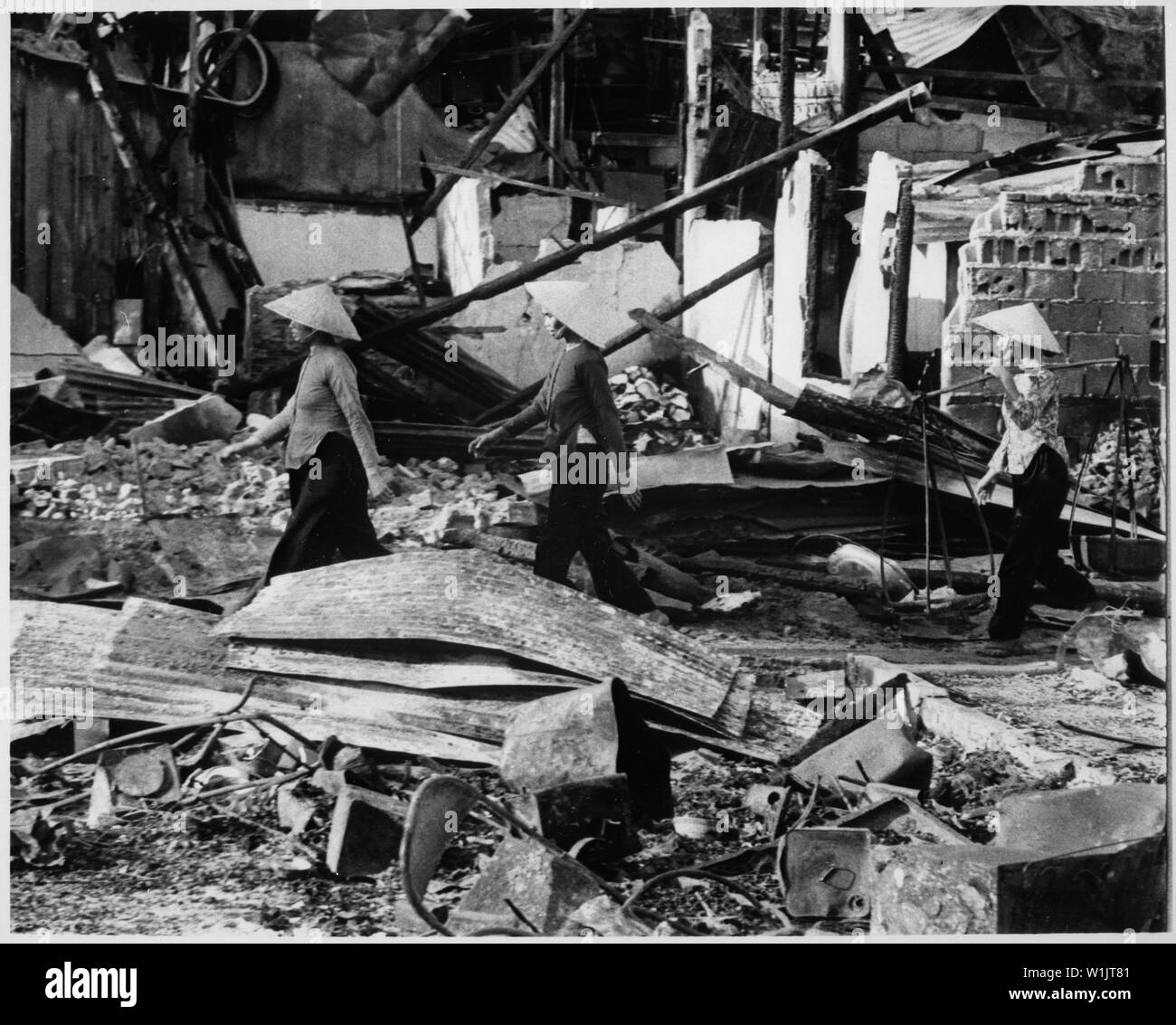 Three Vietnamese women move back into the Cholon area after Viet Cong attack that left a two-block area leveled, in hopes of salvaging meager belongings. Saigon, January 31, 1968., 1958 - 1974; General notes: Use War and Conflict Number 421 when ordering a reproduction or requesting information about this image. Stock Photohttps://www.alamy.com/image-license-details/?v=1https://www.alamy.com/three-vietnamese-women-move-back-into-the-cholon-area-after-viet-cong-attack-that-left-a-two-block-area-leveled-in-hopes-of-salvaging-meager-belongings-saigon-january-31-1968-1958-1974-general-notes-use-war-and-conflict-number-421-when-ordering-a-reproduction-or-requesting-information-about-this-image-image259184353.html
Three Vietnamese women move back into the Cholon area after Viet Cong attack that left a two-block area leveled, in hopes of salvaging meager belongings. Saigon, January 31, 1968., 1958 - 1974; General notes: Use War and Conflict Number 421 when ordering a reproduction or requesting information about this image. Stock Photohttps://www.alamy.com/image-license-details/?v=1https://www.alamy.com/three-vietnamese-women-move-back-into-the-cholon-area-after-viet-cong-attack-that-left-a-two-block-area-leveled-in-hopes-of-salvaging-meager-belongings-saigon-january-31-1968-1958-1974-general-notes-use-war-and-conflict-number-421-when-ordering-a-reproduction-or-requesting-information-about-this-image-image259184353.htmlRMW1JT81–Three Vietnamese women move back into the Cholon area after Viet Cong attack that left a two-block area leveled, in hopes of salvaging meager belongings. Saigon, January 31, 1968., 1958 - 1974; General notes: Use War and Conflict Number 421 when ordering a reproduction or requesting information about this image.
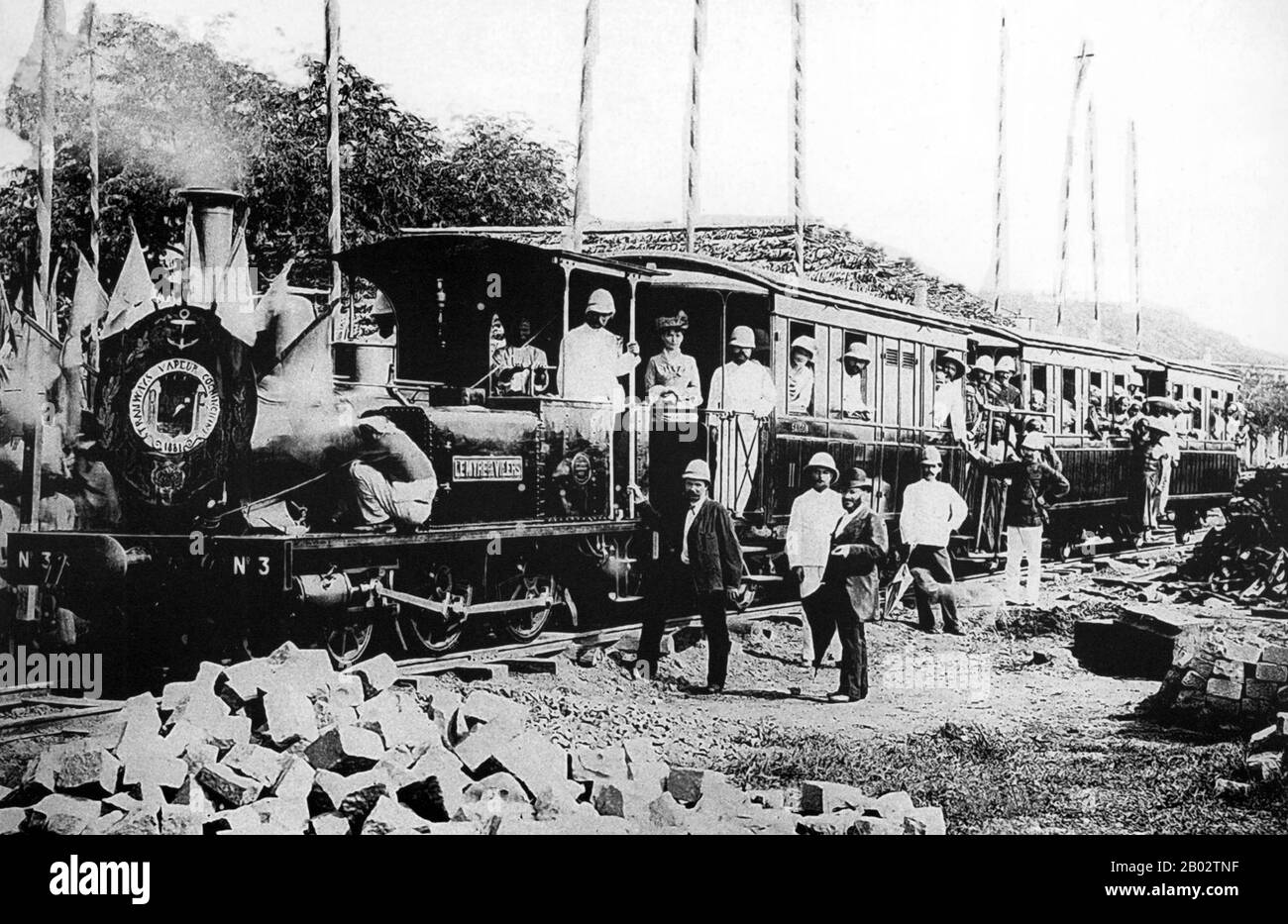 The first railways in Vietnam were established in the 1880s; these included a tram running between the ports of Saigon and Cholon, and a regional rail line connecting Saigon with Mỹ Tho in the Mekong Delta. Railway construction flourished soon afterwards, during the administration of Paul Doumer as Governor-General of French Indochina from 1897 to 1902. Stock Photohttps://www.alamy.com/image-license-details/?v=1https://www.alamy.com/the-first-railways-in-vietnam-were-established-in-the-1880s-these-included-a-tram-running-between-the-ports-of-saigon-and-cholon-and-a-regional-rail-line-connecting-saigon-with-m-tho-in-the-mekong-delta-railway-construction-flourished-soon-afterwards-during-the-administration-of-paul-doumer-as-governor-general-of-french-indochina-from-1897-to-1902-image344270683.html
The first railways in Vietnam were established in the 1880s; these included a tram running between the ports of Saigon and Cholon, and a regional rail line connecting Saigon with Mỹ Tho in the Mekong Delta. Railway construction flourished soon afterwards, during the administration of Paul Doumer as Governor-General of French Indochina from 1897 to 1902. Stock Photohttps://www.alamy.com/image-license-details/?v=1https://www.alamy.com/the-first-railways-in-vietnam-were-established-in-the-1880s-these-included-a-tram-running-between-the-ports-of-saigon-and-cholon-and-a-regional-rail-line-connecting-saigon-with-m-tho-in-the-mekong-delta-railway-construction-flourished-soon-afterwards-during-the-administration-of-paul-doumer-as-governor-general-of-french-indochina-from-1897-to-1902-image344270683.htmlRM2B02TNF–The first railways in Vietnam were established in the 1880s; these included a tram running between the ports of Saigon and Cholon, and a regional rail line connecting Saigon with Mỹ Tho in the Mekong Delta. Railway construction flourished soon afterwards, during the administration of Paul Doumer as Governor-General of French Indochina from 1897 to 1902.
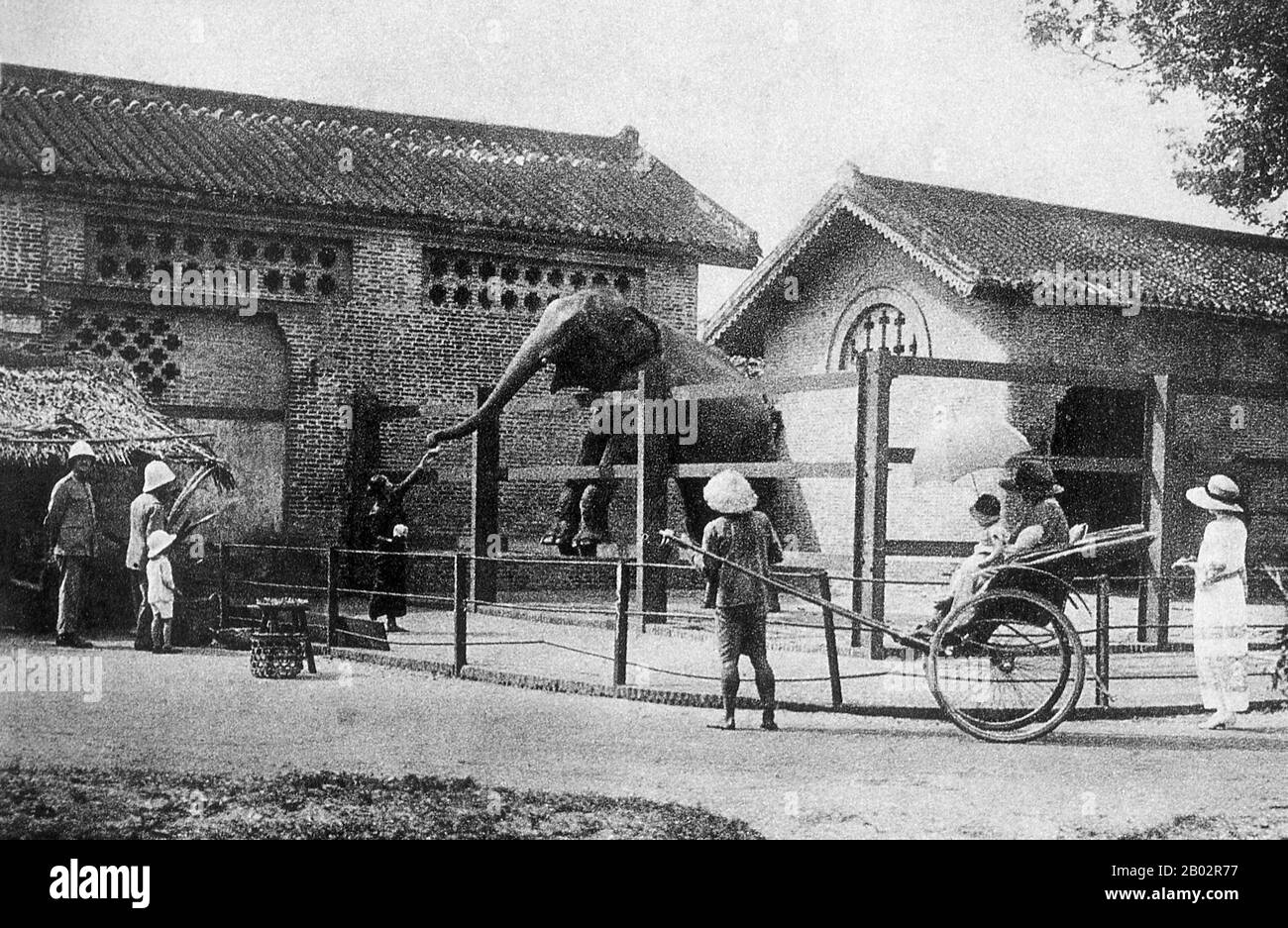 Former Emperor Bao Dai made Saigon the capital of the State of Vietnam in 1949 with himself as head of state. After the Viet Minh gained control of North Vietnam in 1954, it became common to refer to the Saigon government as 'South Vietnam'. The government was renamed the Republic of Vietnam when Bảo Đại was deposed by his Prime Minister Ngo Dinh Diem in a fraudulent referendum in 1955. Saigon and Cholon, an adjacent city with many Sino-Vietnamese residents, were combined into an administrative unit called Đô Thành Sài Gòn (Capital City Saigon). Stock Photohttps://www.alamy.com/image-license-details/?v=1https://www.alamy.com/former-emperor-bao-dai-made-saigon-the-capital-of-the-state-of-vietnam-in-1949-with-himself-as-head-of-state-after-the-viet-minh-gained-control-of-north-vietnam-in-1954-it-became-common-to-refer-to-the-saigon-government-as-south-vietnam-the-government-was-renamed-the-republic-of-vietnam-when-bo-i-was-deposed-by-his-prime-minister-ngo-dinh-diem-in-a-fraudulent-referendum-in-1955-saigon-and-cholon-an-adjacent-city-with-many-sino-vietnamese-residents-were-combined-into-an-administrative-unit-called-thnh-si-gn-capital-city-saigon-image344269499.html
Former Emperor Bao Dai made Saigon the capital of the State of Vietnam in 1949 with himself as head of state. After the Viet Minh gained control of North Vietnam in 1954, it became common to refer to the Saigon government as 'South Vietnam'. The government was renamed the Republic of Vietnam when Bảo Đại was deposed by his Prime Minister Ngo Dinh Diem in a fraudulent referendum in 1955. Saigon and Cholon, an adjacent city with many Sino-Vietnamese residents, were combined into an administrative unit called Đô Thành Sài Gòn (Capital City Saigon). Stock Photohttps://www.alamy.com/image-license-details/?v=1https://www.alamy.com/former-emperor-bao-dai-made-saigon-the-capital-of-the-state-of-vietnam-in-1949-with-himself-as-head-of-state-after-the-viet-minh-gained-control-of-north-vietnam-in-1954-it-became-common-to-refer-to-the-saigon-government-as-south-vietnam-the-government-was-renamed-the-republic-of-vietnam-when-bo-i-was-deposed-by-his-prime-minister-ngo-dinh-diem-in-a-fraudulent-referendum-in-1955-saigon-and-cholon-an-adjacent-city-with-many-sino-vietnamese-residents-were-combined-into-an-administrative-unit-called-thnh-si-gn-capital-city-saigon-image344269499.htmlRM2B02R77–Former Emperor Bao Dai made Saigon the capital of the State of Vietnam in 1949 with himself as head of state. After the Viet Minh gained control of North Vietnam in 1954, it became common to refer to the Saigon government as 'South Vietnam'. The government was renamed the Republic of Vietnam when Bảo Đại was deposed by his Prime Minister Ngo Dinh Diem in a fraudulent referendum in 1955. Saigon and Cholon, an adjacent city with many Sino-Vietnamese residents, were combined into an administrative unit called Đô Thành Sài Gòn (Capital City Saigon).
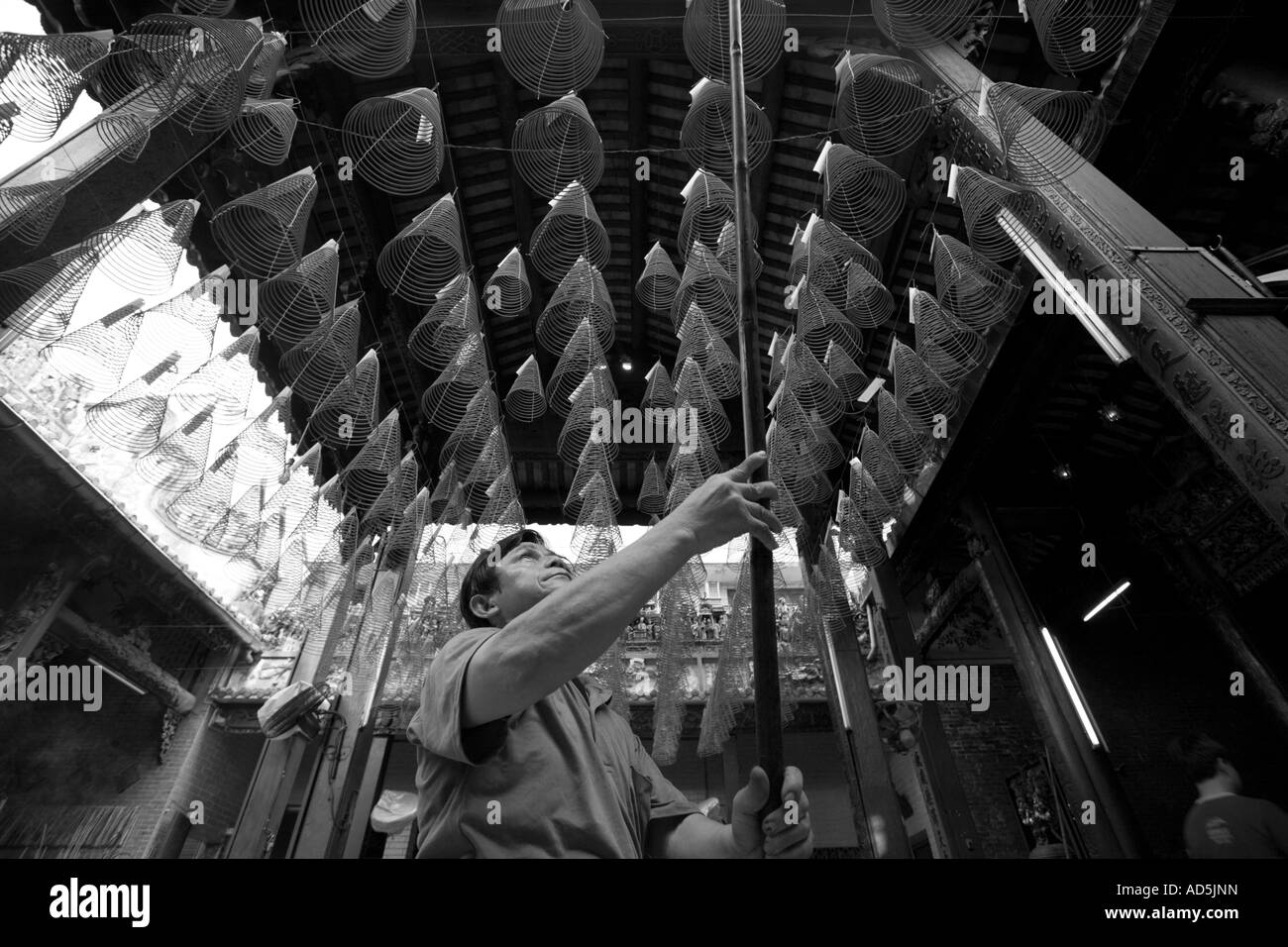 Southeast Asia Vietnam Ho Chi Minh City Worker lifts incense coils burning clouds of smoke inside Thien Hau Pagoda Stock Photohttps://www.alamy.com/image-license-details/?v=1https://www.alamy.com/stock-photo-southeast-asia-vietnam-ho-chi-minh-city-worker-lifts-incense-coils-13312352.html
Southeast Asia Vietnam Ho Chi Minh City Worker lifts incense coils burning clouds of smoke inside Thien Hau Pagoda Stock Photohttps://www.alamy.com/image-license-details/?v=1https://www.alamy.com/stock-photo-southeast-asia-vietnam-ho-chi-minh-city-worker-lifts-incense-coils-13312352.htmlRMAD5JNN–Southeast Asia Vietnam Ho Chi Minh City Worker lifts incense coils burning clouds of smoke inside Thien Hau Pagoda
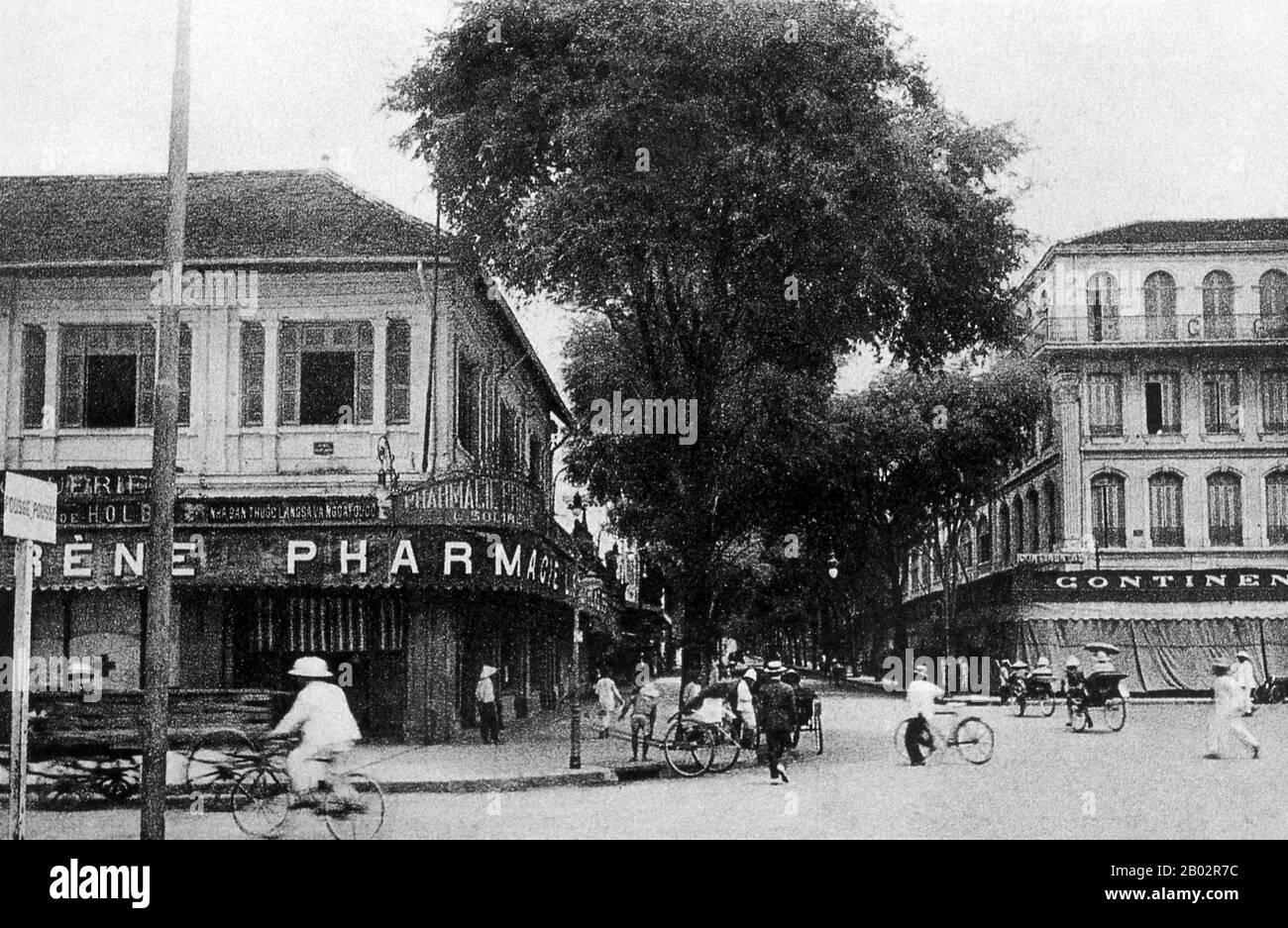 The rue Catinat (Catinat street) is a street, now called Dong Khoi, in Ho Chi Minh City, the former Saigon. It was named for Nicolas Catinat, a 17th and 18th century French marshal. Former Emperor Bảo Đại made Saigon the capital of the State of Vietnam in 1949 with himself as head of state. After the Việt Minh gained control of North Vietnam in 1954, it became common to refer to the Saigon government as 'South Vietnam'. The government was renamed the Republic of Vietnam when Bảo Đại was deposed by his Prime Minister Ngo Dinh Diem in a fraudulent referendum in 1955. Saigon and Cholon, an adja Stock Photohttps://www.alamy.com/image-license-details/?v=1https://www.alamy.com/the-rue-catinat-catinat-street-is-a-street-now-called-dong-khoi-in-ho-chi-minh-city-the-former-saigon-it-was-named-for-nicolas-catinat-a-17th-and-18th-century-french-marshal-former-emperor-bo-i-made-saigon-the-capital-of-the-state-of-vietnam-in-1949-with-himself-as-head-of-state-after-the-vit-minh-gained-control-of-north-vietnam-in-1954-it-became-common-to-refer-to-the-saigon-government-as-south-vietnam-the-government-was-renamed-the-republic-of-vietnam-when-bo-i-was-deposed-by-his-prime-minister-ngo-dinh-diem-in-a-fraudulent-referendum-in-1955-saigon-and-cholon-an-adja-image344269504.html
The rue Catinat (Catinat street) is a street, now called Dong Khoi, in Ho Chi Minh City, the former Saigon. It was named for Nicolas Catinat, a 17th and 18th century French marshal. Former Emperor Bảo Đại made Saigon the capital of the State of Vietnam in 1949 with himself as head of state. After the Việt Minh gained control of North Vietnam in 1954, it became common to refer to the Saigon government as 'South Vietnam'. The government was renamed the Republic of Vietnam when Bảo Đại was deposed by his Prime Minister Ngo Dinh Diem in a fraudulent referendum in 1955. Saigon and Cholon, an adja Stock Photohttps://www.alamy.com/image-license-details/?v=1https://www.alamy.com/the-rue-catinat-catinat-street-is-a-street-now-called-dong-khoi-in-ho-chi-minh-city-the-former-saigon-it-was-named-for-nicolas-catinat-a-17th-and-18th-century-french-marshal-former-emperor-bo-i-made-saigon-the-capital-of-the-state-of-vietnam-in-1949-with-himself-as-head-of-state-after-the-vit-minh-gained-control-of-north-vietnam-in-1954-it-became-common-to-refer-to-the-saigon-government-as-south-vietnam-the-government-was-renamed-the-republic-of-vietnam-when-bo-i-was-deposed-by-his-prime-minister-ngo-dinh-diem-in-a-fraudulent-referendum-in-1955-saigon-and-cholon-an-adja-image344269504.htmlRM2B02R7C–The rue Catinat (Catinat street) is a street, now called Dong Khoi, in Ho Chi Minh City, the former Saigon. It was named for Nicolas Catinat, a 17th and 18th century French marshal. Former Emperor Bảo Đại made Saigon the capital of the State of Vietnam in 1949 with himself as head of state. After the Việt Minh gained control of North Vietnam in 1954, it became common to refer to the Saigon government as 'South Vietnam'. The government was renamed the Republic of Vietnam when Bảo Đại was deposed by his Prime Minister Ngo Dinh Diem in a fraudulent referendum in 1955. Saigon and Cholon, an adja
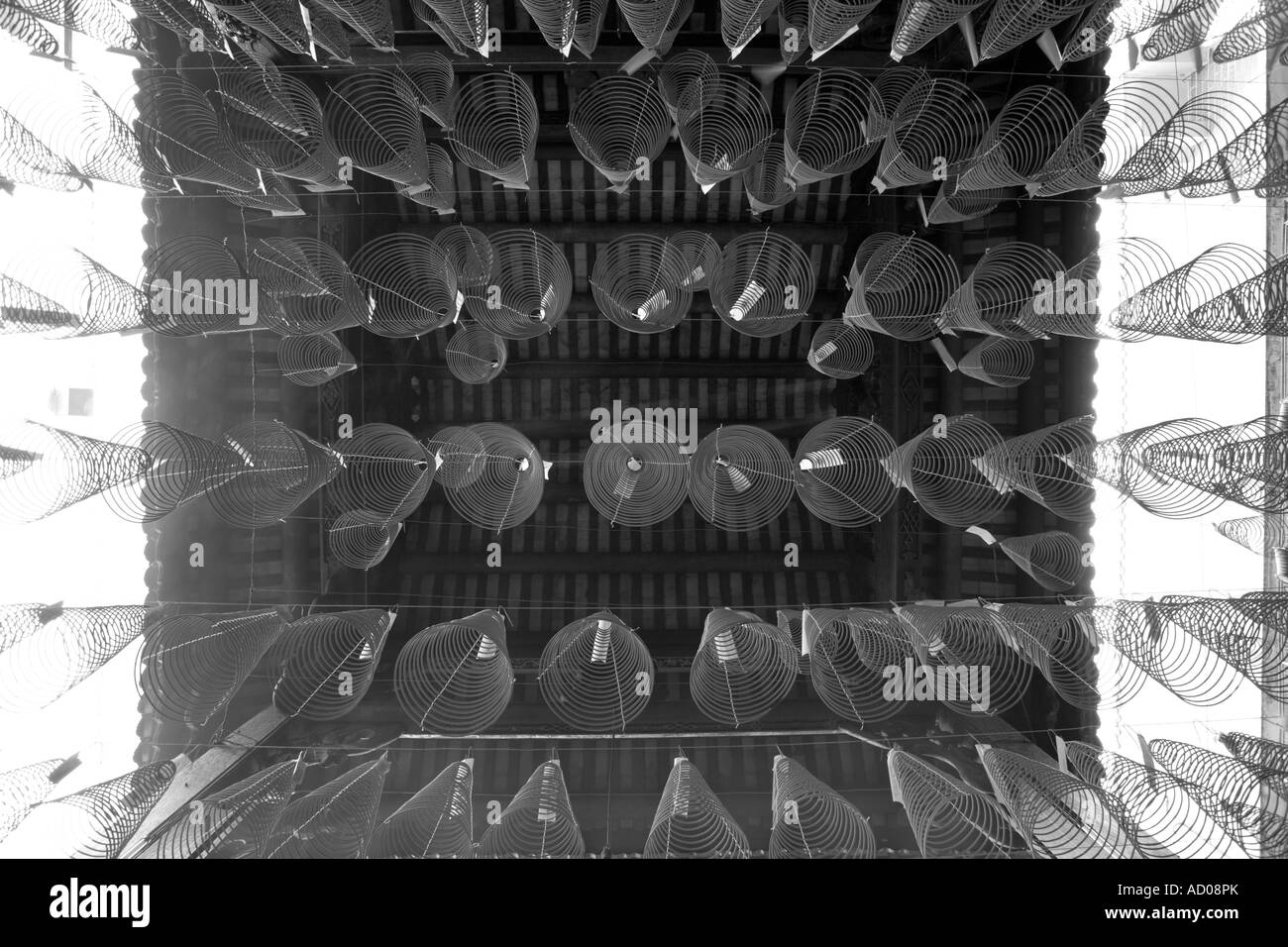 Southeast Asia Vietnam Ho Chi Minh City Incense coils burn in clouds of smoke inside Thien Hau Pagoda Stock Photohttps://www.alamy.com/image-license-details/?v=1https://www.alamy.com/stock-photo-southeast-asia-vietnam-ho-chi-minh-city-incense-coils-burn-in-clouds-13261962.html
Southeast Asia Vietnam Ho Chi Minh City Incense coils burn in clouds of smoke inside Thien Hau Pagoda Stock Photohttps://www.alamy.com/image-license-details/?v=1https://www.alamy.com/stock-photo-southeast-asia-vietnam-ho-chi-minh-city-incense-coils-burn-in-clouds-13261962.htmlRMAD08PK–Southeast Asia Vietnam Ho Chi Minh City Incense coils burn in clouds of smoke inside Thien Hau Pagoda
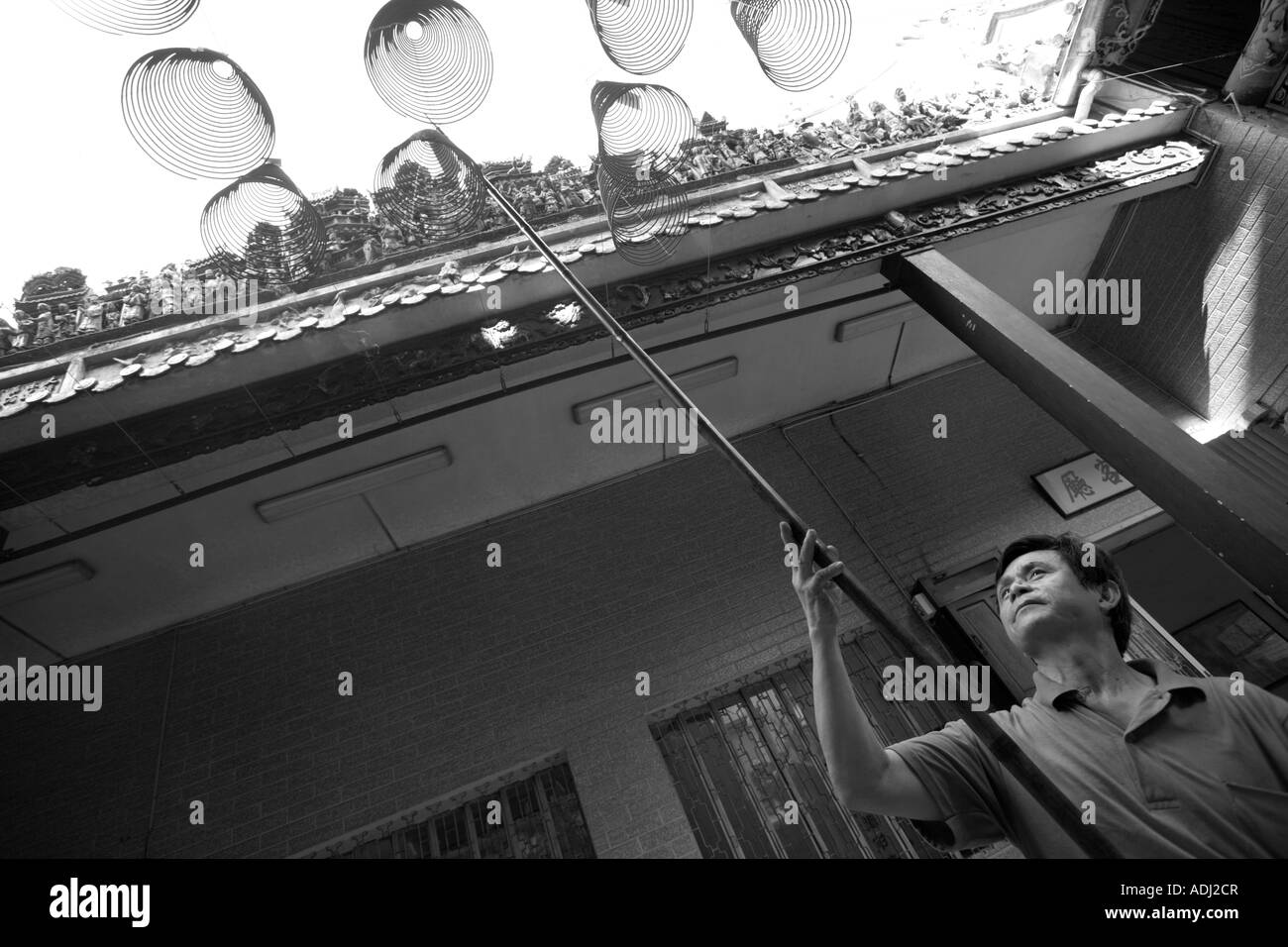 Southeast Asia Vietnam Ho Chi Minh City Worker lifts incense coils burning clouds of smoke inside Thien Hau Pagoda Stock Photohttps://www.alamy.com/image-license-details/?v=1https://www.alamy.com/stock-photo-southeast-asia-vietnam-ho-chi-minh-city-worker-lifts-incense-coils-13429174.html
Southeast Asia Vietnam Ho Chi Minh City Worker lifts incense coils burning clouds of smoke inside Thien Hau Pagoda Stock Photohttps://www.alamy.com/image-license-details/?v=1https://www.alamy.com/stock-photo-southeast-asia-vietnam-ho-chi-minh-city-worker-lifts-incense-coils-13429174.htmlRMADJ2CR–Southeast Asia Vietnam Ho Chi Minh City Worker lifts incense coils burning clouds of smoke inside Thien Hau Pagoda